Sustainable Tourism Development in Philippines
VerifiedAdded on 2023/04/11
|17
|5196
|498
AI Summary
This report aims to develop the understanding of sustainable tourism, its promotion, and the way in which it can be accomplished. It discusses the benefits of tourism development planning for stakeholders in the Philippines, the advantages and disadvantages of public/private sector partnerships, features of tourism development planning at different levels, the significance of interactive planning systems, and measures to measure tourist impact. It also explores the concept of sustainability in tourism development with reference to the Philippines.
Contribute Materials
Your contribution can guide someone’s learning journey. Share your
documents today.
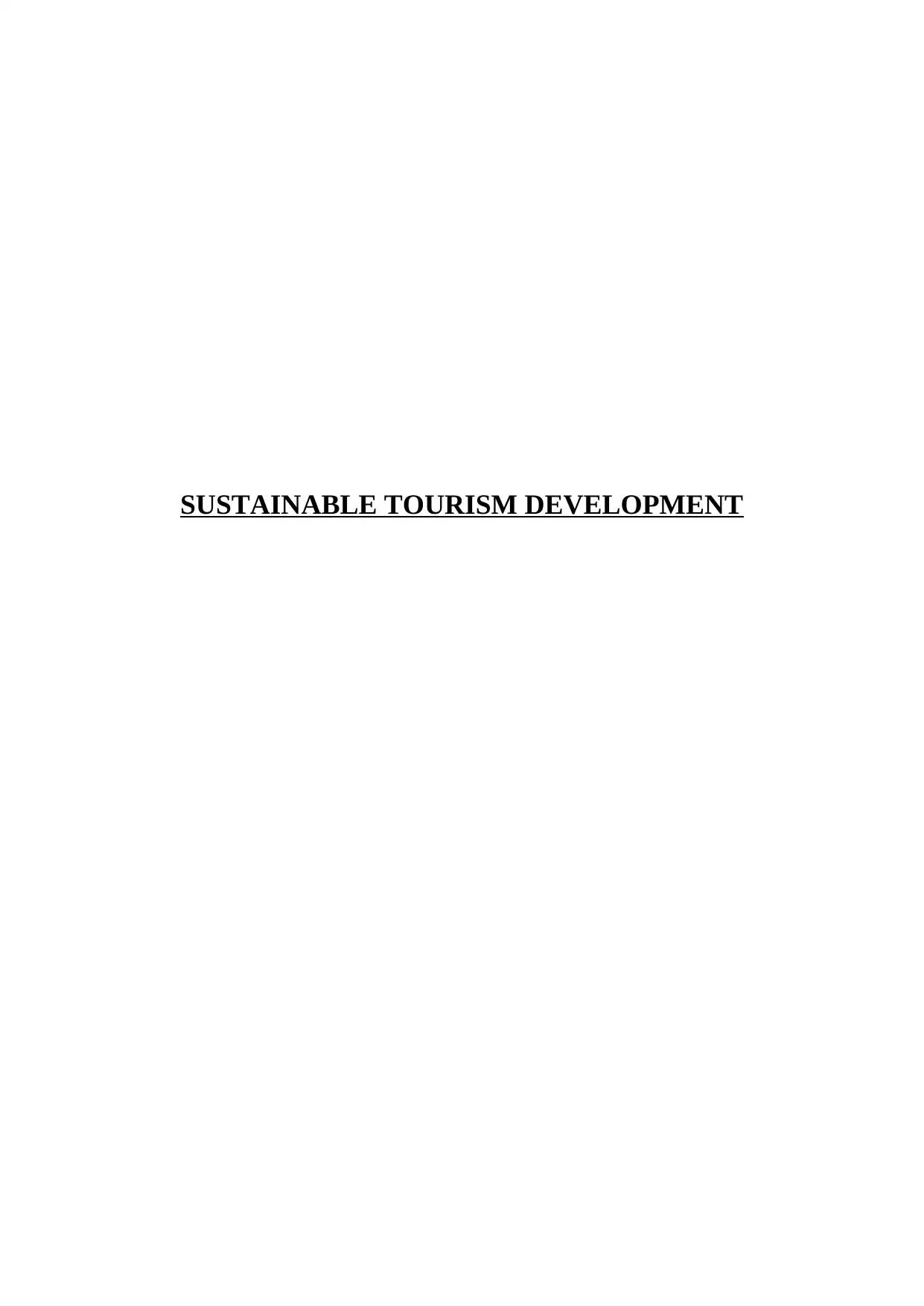
SUSTAINABLE TOURISM DEVELOPMENT
Secure Best Marks with AI Grader
Need help grading? Try our AI Grader for instant feedback on your assignments.
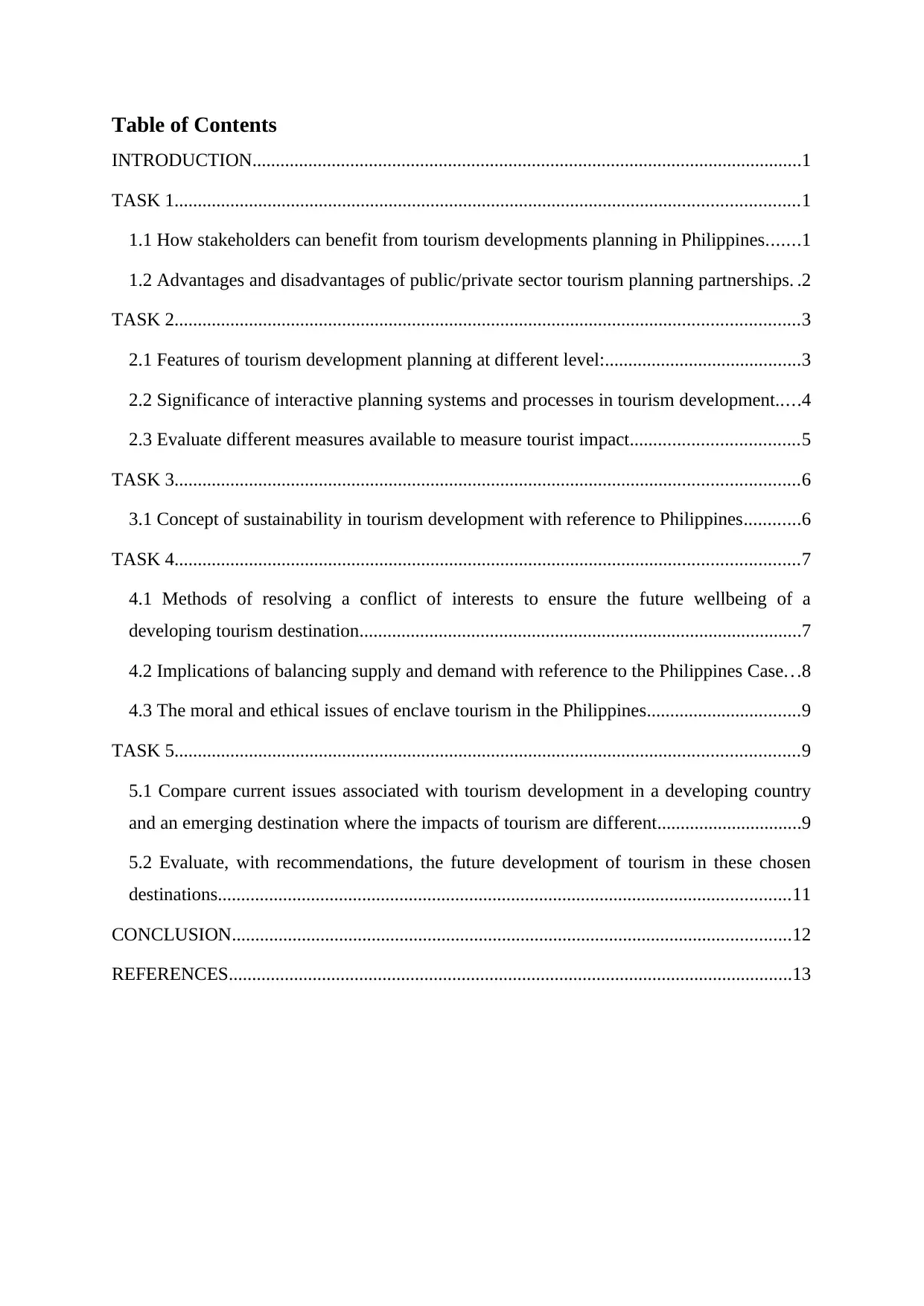
Table of Contents
INTRODUCTION......................................................................................................................1
TASK 1......................................................................................................................................1
1.1 How stakeholders can benefit from tourism developments planning in Philippines.......1
1.2 Advantages and disadvantages of public/private sector tourism planning partnerships. .2
TASK 2......................................................................................................................................3
2.1 Features of tourism development planning at different level:..........................................3
2.2 Significance of interactive planning systems and processes in tourism development.....4
2.3 Evaluate different measures available to measure tourist impact....................................5
TASK 3......................................................................................................................................6
3.1 Concept of sustainability in tourism development with reference to Philippines............6
TASK 4......................................................................................................................................7
4.1 Methods of resolving a conflict of interests to ensure the future wellbeing of a
developing tourism destination...............................................................................................7
4.2 Implications of balancing supply and demand with reference to the Philippines Case. . .8
4.3 The moral and ethical issues of enclave tourism in the Philippines.................................9
TASK 5......................................................................................................................................9
5.1 Compare current issues associated with tourism development in a developing country
and an emerging destination where the impacts of tourism are different...............................9
5.2 Evaluate, with recommendations, the future development of tourism in these chosen
destinations...........................................................................................................................11
CONCLUSION........................................................................................................................12
REFERENCES.........................................................................................................................13
INTRODUCTION......................................................................................................................1
TASK 1......................................................................................................................................1
1.1 How stakeholders can benefit from tourism developments planning in Philippines.......1
1.2 Advantages and disadvantages of public/private sector tourism planning partnerships. .2
TASK 2......................................................................................................................................3
2.1 Features of tourism development planning at different level:..........................................3
2.2 Significance of interactive planning systems and processes in tourism development.....4
2.3 Evaluate different measures available to measure tourist impact....................................5
TASK 3......................................................................................................................................6
3.1 Concept of sustainability in tourism development with reference to Philippines............6
TASK 4......................................................................................................................................7
4.1 Methods of resolving a conflict of interests to ensure the future wellbeing of a
developing tourism destination...............................................................................................7
4.2 Implications of balancing supply and demand with reference to the Philippines Case. . .8
4.3 The moral and ethical issues of enclave tourism in the Philippines.................................9
TASK 5......................................................................................................................................9
5.1 Compare current issues associated with tourism development in a developing country
and an emerging destination where the impacts of tourism are different...............................9
5.2 Evaluate, with recommendations, the future development of tourism in these chosen
destinations...........................................................................................................................11
CONCLUSION........................................................................................................................12
REFERENCES.........................................................................................................................13
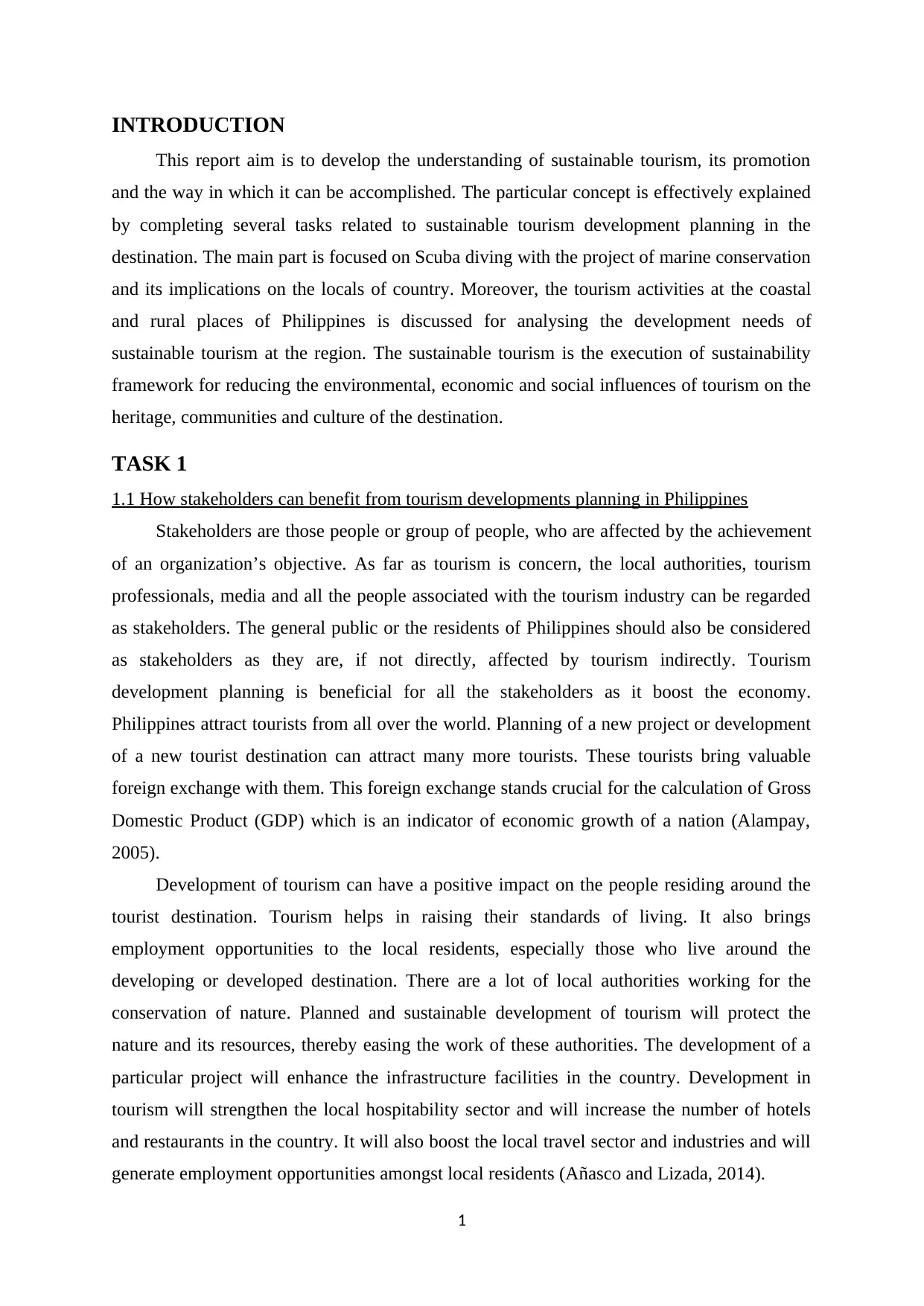
INTRODUCTION
This report aim is to develop the understanding of sustainable tourism, its promotion
and the way in which it can be accomplished. The particular concept is effectively explained
by completing several tasks related to sustainable tourism development planning in the
destination. The main part is focused on Scuba diving with the project of marine conservation
and its implications on the locals of country. Moreover, the tourism activities at the coastal
and rural places of Philippines is discussed for analysing the development needs of
sustainable tourism at the region. The sustainable tourism is the execution of sustainability
framework for reducing the environmental, economic and social influences of tourism on the
heritage, communities and culture of the destination.
TASK 1
1.1 How stakeholders can benefit from tourism developments planning in Philippines
Stakeholders are those people or group of people, who are affected by the achievement
of an organization’s objective. As far as tourism is concern, the local authorities, tourism
professionals, media and all the people associated with the tourism industry can be regarded
as stakeholders. The general public or the residents of Philippines should also be considered
as stakeholders as they are, if not directly, affected by tourism indirectly. Tourism
development planning is beneficial for all the stakeholders as it boost the economy.
Philippines attract tourists from all over the world. Planning of a new project or development
of a new tourist destination can attract many more tourists. These tourists bring valuable
foreign exchange with them. This foreign exchange stands crucial for the calculation of Gross
Domestic Product (GDP) which is an indicator of economic growth of a nation (Alampay,
2005).
Development of tourism can have a positive impact on the people residing around the
tourist destination. Tourism helps in raising their standards of living. It also brings
employment opportunities to the local residents, especially those who live around the
developing or developed destination. There are a lot of local authorities working for the
conservation of nature. Planned and sustainable development of tourism will protect the
nature and its resources, thereby easing the work of these authorities. The development of a
particular project will enhance the infrastructure facilities in the country. Development in
tourism will strengthen the local hospitability sector and will increase the number of hotels
and restaurants in the country. It will also boost the local travel sector and industries and will
generate employment opportunities amongst local residents (Añasco and Lizada, 2014).
1
This report aim is to develop the understanding of sustainable tourism, its promotion
and the way in which it can be accomplished. The particular concept is effectively explained
by completing several tasks related to sustainable tourism development planning in the
destination. The main part is focused on Scuba diving with the project of marine conservation
and its implications on the locals of country. Moreover, the tourism activities at the coastal
and rural places of Philippines is discussed for analysing the development needs of
sustainable tourism at the region. The sustainable tourism is the execution of sustainability
framework for reducing the environmental, economic and social influences of tourism on the
heritage, communities and culture of the destination.
TASK 1
1.1 How stakeholders can benefit from tourism developments planning in Philippines
Stakeholders are those people or group of people, who are affected by the achievement
of an organization’s objective. As far as tourism is concern, the local authorities, tourism
professionals, media and all the people associated with the tourism industry can be regarded
as stakeholders. The general public or the residents of Philippines should also be considered
as stakeholders as they are, if not directly, affected by tourism indirectly. Tourism
development planning is beneficial for all the stakeholders as it boost the economy.
Philippines attract tourists from all over the world. Planning of a new project or development
of a new tourist destination can attract many more tourists. These tourists bring valuable
foreign exchange with them. This foreign exchange stands crucial for the calculation of Gross
Domestic Product (GDP) which is an indicator of economic growth of a nation (Alampay,
2005).
Development of tourism can have a positive impact on the people residing around the
tourist destination. Tourism helps in raising their standards of living. It also brings
employment opportunities to the local residents, especially those who live around the
developing or developed destination. There are a lot of local authorities working for the
conservation of nature. Planned and sustainable development of tourism will protect the
nature and its resources, thereby easing the work of these authorities. The development of a
particular project will enhance the infrastructure facilities in the country. Development in
tourism will strengthen the local hospitability sector and will increase the number of hotels
and restaurants in the country. It will also boost the local travel sector and industries and will
generate employment opportunities amongst local residents (Añasco and Lizada, 2014).
1
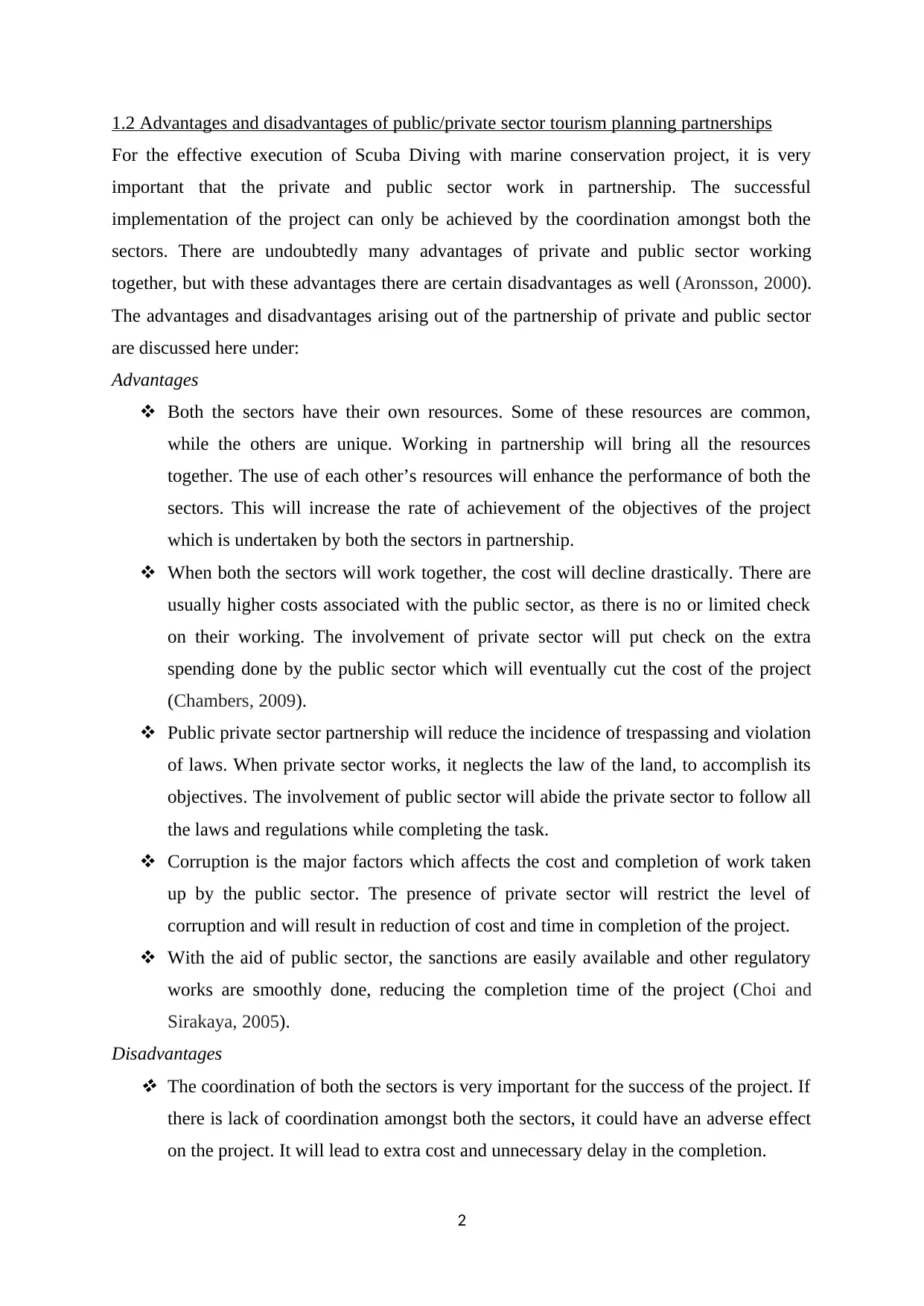
1.2 Advantages and disadvantages of public/private sector tourism planning partnerships
For the effective execution of Scuba Diving with marine conservation project, it is very
important that the private and public sector work in partnership. The successful
implementation of the project can only be achieved by the coordination amongst both the
sectors. There are undoubtedly many advantages of private and public sector working
together, but with these advantages there are certain disadvantages as well (Aronsson, 2000).
The advantages and disadvantages arising out of the partnership of private and public sector
are discussed here under:
Advantages
Both the sectors have their own resources. Some of these resources are common,
while the others are unique. Working in partnership will bring all the resources
together. The use of each other’s resources will enhance the performance of both the
sectors. This will increase the rate of achievement of the objectives of the project
which is undertaken by both the sectors in partnership.
When both the sectors will work together, the cost will decline drastically. There are
usually higher costs associated with the public sector, as there is no or limited check
on their working. The involvement of private sector will put check on the extra
spending done by the public sector which will eventually cut the cost of the project
(Chambers, 2009).
Public private sector partnership will reduce the incidence of trespassing and violation
of laws. When private sector works, it neglects the law of the land, to accomplish its
objectives. The involvement of public sector will abide the private sector to follow all
the laws and regulations while completing the task.
Corruption is the major factors which affects the cost and completion of work taken
up by the public sector. The presence of private sector will restrict the level of
corruption and will result in reduction of cost and time in completion of the project.
With the aid of public sector, the sanctions are easily available and other regulatory
works are smoothly done, reducing the completion time of the project (Choi and
Sirakaya, 2005).
Disadvantages The coordination of both the sectors is very important for the success of the project. If
there is lack of coordination amongst both the sectors, it could have an adverse effect
on the project. It will lead to extra cost and unnecessary delay in the completion.
2
For the effective execution of Scuba Diving with marine conservation project, it is very
important that the private and public sector work in partnership. The successful
implementation of the project can only be achieved by the coordination amongst both the
sectors. There are undoubtedly many advantages of private and public sector working
together, but with these advantages there are certain disadvantages as well (Aronsson, 2000).
The advantages and disadvantages arising out of the partnership of private and public sector
are discussed here under:
Advantages
Both the sectors have their own resources. Some of these resources are common,
while the others are unique. Working in partnership will bring all the resources
together. The use of each other’s resources will enhance the performance of both the
sectors. This will increase the rate of achievement of the objectives of the project
which is undertaken by both the sectors in partnership.
When both the sectors will work together, the cost will decline drastically. There are
usually higher costs associated with the public sector, as there is no or limited check
on their working. The involvement of private sector will put check on the extra
spending done by the public sector which will eventually cut the cost of the project
(Chambers, 2009).
Public private sector partnership will reduce the incidence of trespassing and violation
of laws. When private sector works, it neglects the law of the land, to accomplish its
objectives. The involvement of public sector will abide the private sector to follow all
the laws and regulations while completing the task.
Corruption is the major factors which affects the cost and completion of work taken
up by the public sector. The presence of private sector will restrict the level of
corruption and will result in reduction of cost and time in completion of the project.
With the aid of public sector, the sanctions are easily available and other regulatory
works are smoothly done, reducing the completion time of the project (Choi and
Sirakaya, 2005).
Disadvantages The coordination of both the sectors is very important for the success of the project. If
there is lack of coordination amongst both the sectors, it could have an adverse effect
on the project. It will lead to extra cost and unnecessary delay in the completion.
2
Secure Best Marks with AI Grader
Need help grading? Try our AI Grader for instant feedback on your assignments.
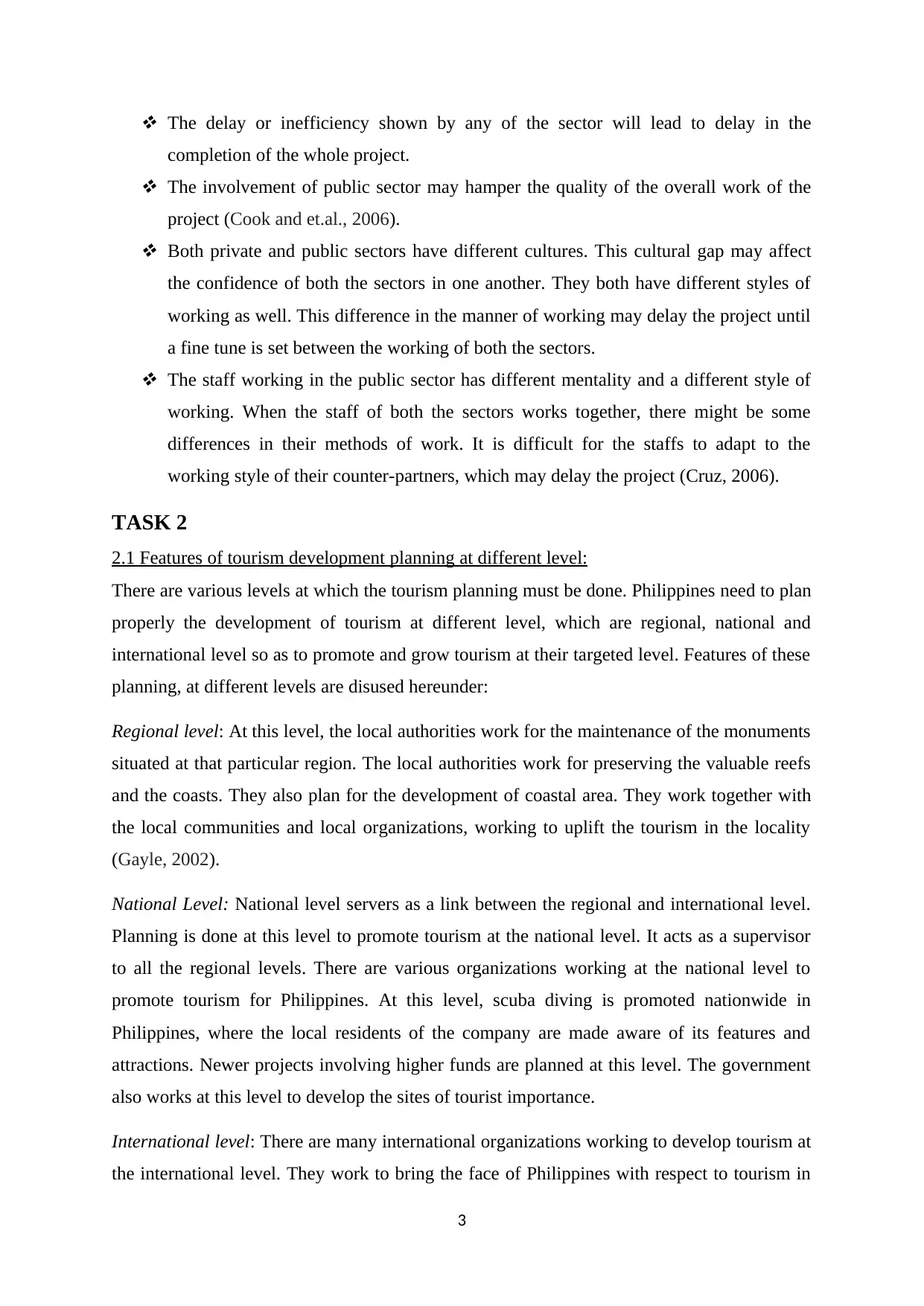
The delay or inefficiency shown by any of the sector will lead to delay in the
completion of the whole project. The involvement of public sector may hamper the quality of the overall work of the
project (Cook and et.al., 2006). Both private and public sectors have different cultures. This cultural gap may affect
the confidence of both the sectors in one another. They both have different styles of
working as well. This difference in the manner of working may delay the project until
a fine tune is set between the working of both the sectors. The staff working in the public sector has different mentality and a different style of
working. When the staff of both the sectors works together, there might be some
differences in their methods of work. It is difficult for the staffs to adapt to the
working style of their counter-partners, which may delay the project (Cruz, 2006).
TASK 2
2.1 Features of tourism development planning at different level:
There are various levels at which the tourism planning must be done. Philippines need to plan
properly the development of tourism at different level, which are regional, national and
international level so as to promote and grow tourism at their targeted level. Features of these
planning, at different levels are disused hereunder:
Regional level: At this level, the local authorities work for the maintenance of the monuments
situated at that particular region. The local authorities work for preserving the valuable reefs
and the coasts. They also plan for the development of coastal area. They work together with
the local communities and local organizations, working to uplift the tourism in the locality
(Gayle, 2002).
National Level: National level servers as a link between the regional and international level.
Planning is done at this level to promote tourism at the national level. It acts as a supervisor
to all the regional levels. There are various organizations working at the national level to
promote tourism for Philippines. At this level, scuba diving is promoted nationwide in
Philippines, where the local residents of the company are made aware of its features and
attractions. Newer projects involving higher funds are planned at this level. The government
also works at this level to develop the sites of tourist importance.
International level: There are many international organizations working to develop tourism at
the international level. They work to bring the face of Philippines with respect to tourism in
3
completion of the whole project. The involvement of public sector may hamper the quality of the overall work of the
project (Cook and et.al., 2006). Both private and public sectors have different cultures. This cultural gap may affect
the confidence of both the sectors in one another. They both have different styles of
working as well. This difference in the manner of working may delay the project until
a fine tune is set between the working of both the sectors. The staff working in the public sector has different mentality and a different style of
working. When the staff of both the sectors works together, there might be some
differences in their methods of work. It is difficult for the staffs to adapt to the
working style of their counter-partners, which may delay the project (Cruz, 2006).
TASK 2
2.1 Features of tourism development planning at different level:
There are various levels at which the tourism planning must be done. Philippines need to plan
properly the development of tourism at different level, which are regional, national and
international level so as to promote and grow tourism at their targeted level. Features of these
planning, at different levels are disused hereunder:
Regional level: At this level, the local authorities work for the maintenance of the monuments
situated at that particular region. The local authorities work for preserving the valuable reefs
and the coasts. They also plan for the development of coastal area. They work together with
the local communities and local organizations, working to uplift the tourism in the locality
(Gayle, 2002).
National Level: National level servers as a link between the regional and international level.
Planning is done at this level to promote tourism at the national level. It acts as a supervisor
to all the regional levels. There are various organizations working at the national level to
promote tourism for Philippines. At this level, scuba diving is promoted nationwide in
Philippines, where the local residents of the company are made aware of its features and
attractions. Newer projects involving higher funds are planned at this level. The government
also works at this level to develop the sites of tourist importance.
International level: There are many international organizations working to develop tourism at
the international level. They work to bring the face of Philippines with respect to tourism in
3
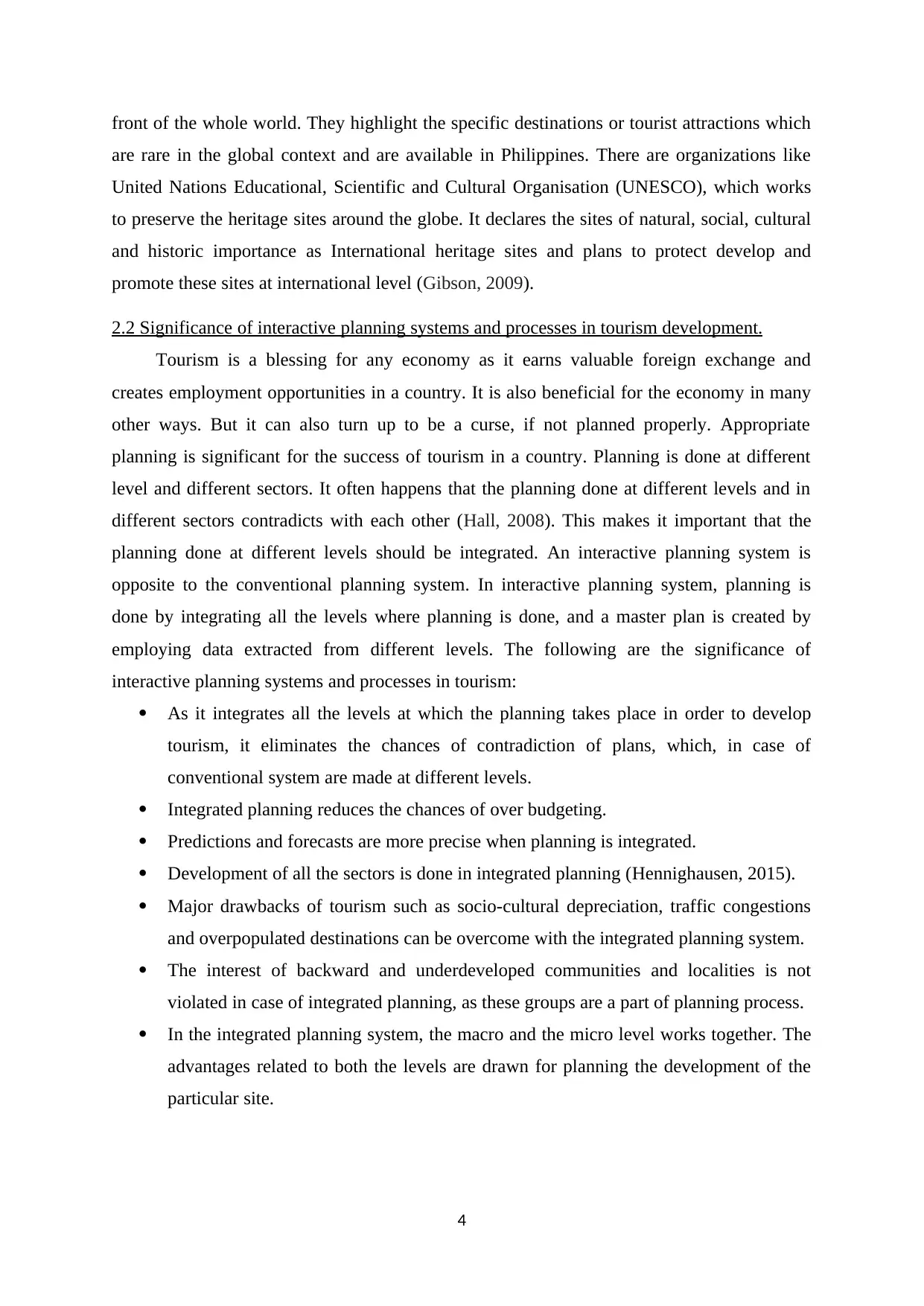
front of the whole world. They highlight the specific destinations or tourist attractions which
are rare in the global context and are available in Philippines. There are organizations like
United Nations Educational, Scientific and Cultural Organisation (UNESCO), which works
to preserve the heritage sites around the globe. It declares the sites of natural, social, cultural
and historic importance as International heritage sites and plans to protect develop and
promote these sites at international level (Gibson, 2009).
2.2 Significance of interactive planning systems and processes in tourism development.
Tourism is a blessing for any economy as it earns valuable foreign exchange and
creates employment opportunities in a country. It is also beneficial for the economy in many
other ways. But it can also turn up to be a curse, if not planned properly. Appropriate
planning is significant for the success of tourism in a country. Planning is done at different
level and different sectors. It often happens that the planning done at different levels and in
different sectors contradicts with each other (Hall, 2008). This makes it important that the
planning done at different levels should be integrated. An interactive planning system is
opposite to the conventional planning system. In interactive planning system, planning is
done by integrating all the levels where planning is done, and a master plan is created by
employing data extracted from different levels. The following are the significance of
interactive planning systems and processes in tourism:
As it integrates all the levels at which the planning takes place in order to develop
tourism, it eliminates the chances of contradiction of plans, which, in case of
conventional system are made at different levels.
Integrated planning reduces the chances of over budgeting.
Predictions and forecasts are more precise when planning is integrated.
Development of all the sectors is done in integrated planning (Hennighausen, 2015).
Major drawbacks of tourism such as socio-cultural depreciation, traffic congestions
and overpopulated destinations can be overcome with the integrated planning system.
The interest of backward and underdeveloped communities and localities is not
violated in case of integrated planning, as these groups are a part of planning process.
In the integrated planning system, the macro and the micro level works together. The
advantages related to both the levels are drawn for planning the development of the
particular site.
4
are rare in the global context and are available in Philippines. There are organizations like
United Nations Educational, Scientific and Cultural Organisation (UNESCO), which works
to preserve the heritage sites around the globe. It declares the sites of natural, social, cultural
and historic importance as International heritage sites and plans to protect develop and
promote these sites at international level (Gibson, 2009).
2.2 Significance of interactive planning systems and processes in tourism development.
Tourism is a blessing for any economy as it earns valuable foreign exchange and
creates employment opportunities in a country. It is also beneficial for the economy in many
other ways. But it can also turn up to be a curse, if not planned properly. Appropriate
planning is significant for the success of tourism in a country. Planning is done at different
level and different sectors. It often happens that the planning done at different levels and in
different sectors contradicts with each other (Hall, 2008). This makes it important that the
planning done at different levels should be integrated. An interactive planning system is
opposite to the conventional planning system. In interactive planning system, planning is
done by integrating all the levels where planning is done, and a master plan is created by
employing data extracted from different levels. The following are the significance of
interactive planning systems and processes in tourism:
As it integrates all the levels at which the planning takes place in order to develop
tourism, it eliminates the chances of contradiction of plans, which, in case of
conventional system are made at different levels.
Integrated planning reduces the chances of over budgeting.
Predictions and forecasts are more precise when planning is integrated.
Development of all the sectors is done in integrated planning (Hennighausen, 2015).
Major drawbacks of tourism such as socio-cultural depreciation, traffic congestions
and overpopulated destinations can be overcome with the integrated planning system.
The interest of backward and underdeveloped communities and localities is not
violated in case of integrated planning, as these groups are a part of planning process.
In the integrated planning system, the macro and the micro level works together. The
advantages related to both the levels are drawn for planning the development of the
particular site.
4
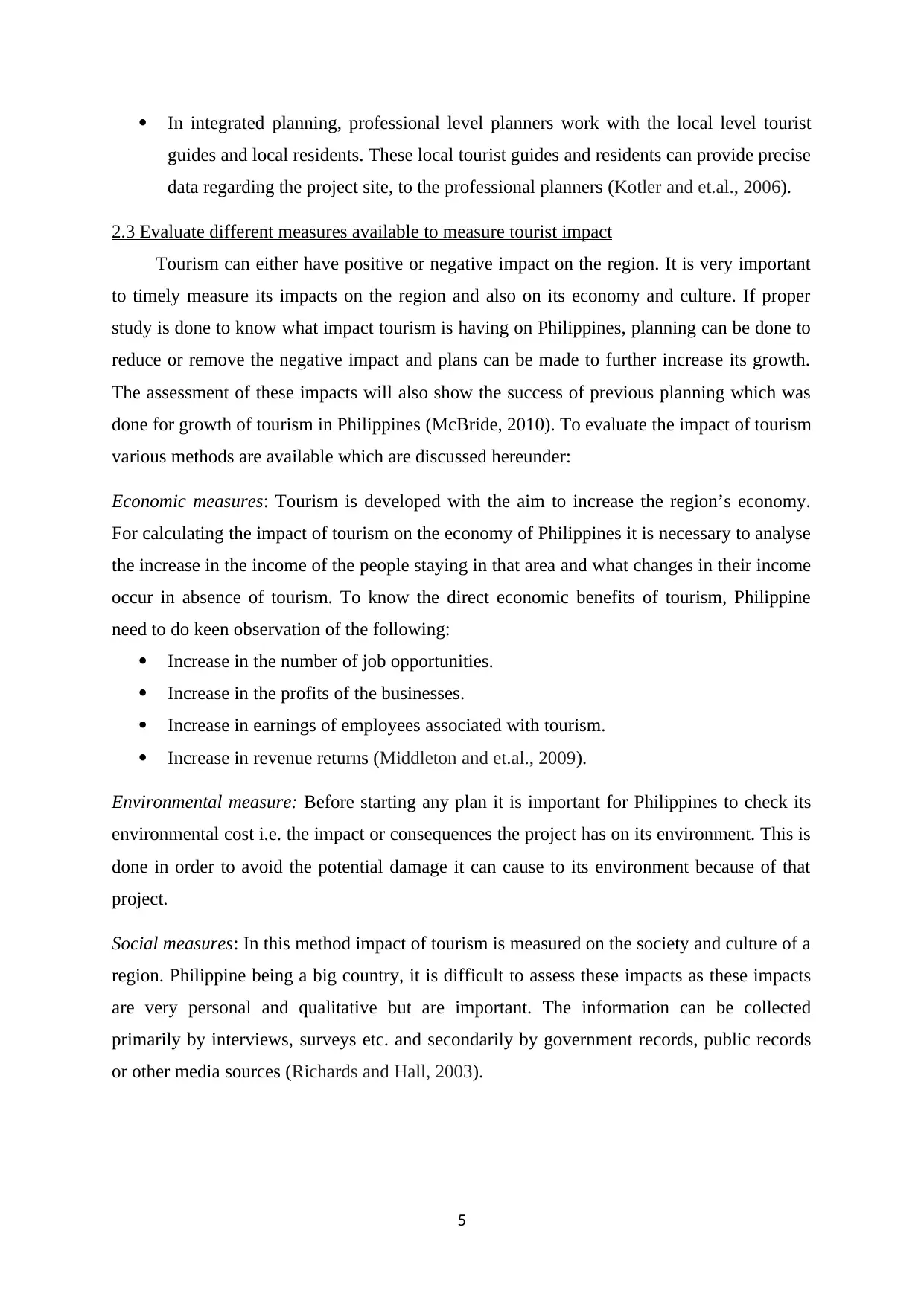
In integrated planning, professional level planners work with the local level tourist
guides and local residents. These local tourist guides and residents can provide precise
data regarding the project site, to the professional planners (Kotler and et.al., 2006).
2.3 Evaluate different measures available to measure tourist impact
Tourism can either have positive or negative impact on the region. It is very important
to timely measure its impacts on the region and also on its economy and culture. If proper
study is done to know what impact tourism is having on Philippines, planning can be done to
reduce or remove the negative impact and plans can be made to further increase its growth.
The assessment of these impacts will also show the success of previous planning which was
done for growth of tourism in Philippines (McBride, 2010). To evaluate the impact of tourism
various methods are available which are discussed hereunder:
Economic measures: Tourism is developed with the aim to increase the region’s economy.
For calculating the impact of tourism on the economy of Philippines it is necessary to analyse
the increase in the income of the people staying in that area and what changes in their income
occur in absence of tourism. To know the direct economic benefits of tourism, Philippine
need to do keen observation of the following:
Increase in the number of job opportunities.
Increase in the profits of the businesses.
Increase in earnings of employees associated with tourism.
Increase in revenue returns (Middleton and et.al., 2009).
Environmental measure: Before starting any plan it is important for Philippines to check its
environmental cost i.e. the impact or consequences the project has on its environment. This is
done in order to avoid the potential damage it can cause to its environment because of that
project.
Social measures: In this method impact of tourism is measured on the society and culture of a
region. Philippine being a big country, it is difficult to assess these impacts as these impacts
are very personal and qualitative but are important. The information can be collected
primarily by interviews, surveys etc. and secondarily by government records, public records
or other media sources (Richards and Hall, 2003).
5
guides and local residents. These local tourist guides and residents can provide precise
data regarding the project site, to the professional planners (Kotler and et.al., 2006).
2.3 Evaluate different measures available to measure tourist impact
Tourism can either have positive or negative impact on the region. It is very important
to timely measure its impacts on the region and also on its economy and culture. If proper
study is done to know what impact tourism is having on Philippines, planning can be done to
reduce or remove the negative impact and plans can be made to further increase its growth.
The assessment of these impacts will also show the success of previous planning which was
done for growth of tourism in Philippines (McBride, 2010). To evaluate the impact of tourism
various methods are available which are discussed hereunder:
Economic measures: Tourism is developed with the aim to increase the region’s economy.
For calculating the impact of tourism on the economy of Philippines it is necessary to analyse
the increase in the income of the people staying in that area and what changes in their income
occur in absence of tourism. To know the direct economic benefits of tourism, Philippine
need to do keen observation of the following:
Increase in the number of job opportunities.
Increase in the profits of the businesses.
Increase in earnings of employees associated with tourism.
Increase in revenue returns (Middleton and et.al., 2009).
Environmental measure: Before starting any plan it is important for Philippines to check its
environmental cost i.e. the impact or consequences the project has on its environment. This is
done in order to avoid the potential damage it can cause to its environment because of that
project.
Social measures: In this method impact of tourism is measured on the society and culture of a
region. Philippine being a big country, it is difficult to assess these impacts as these impacts
are very personal and qualitative but are important. The information can be collected
primarily by interviews, surveys etc. and secondarily by government records, public records
or other media sources (Richards and Hall, 2003).
5
Paraphrase This Document
Need a fresh take? Get an instant paraphrase of this document with our AI Paraphraser
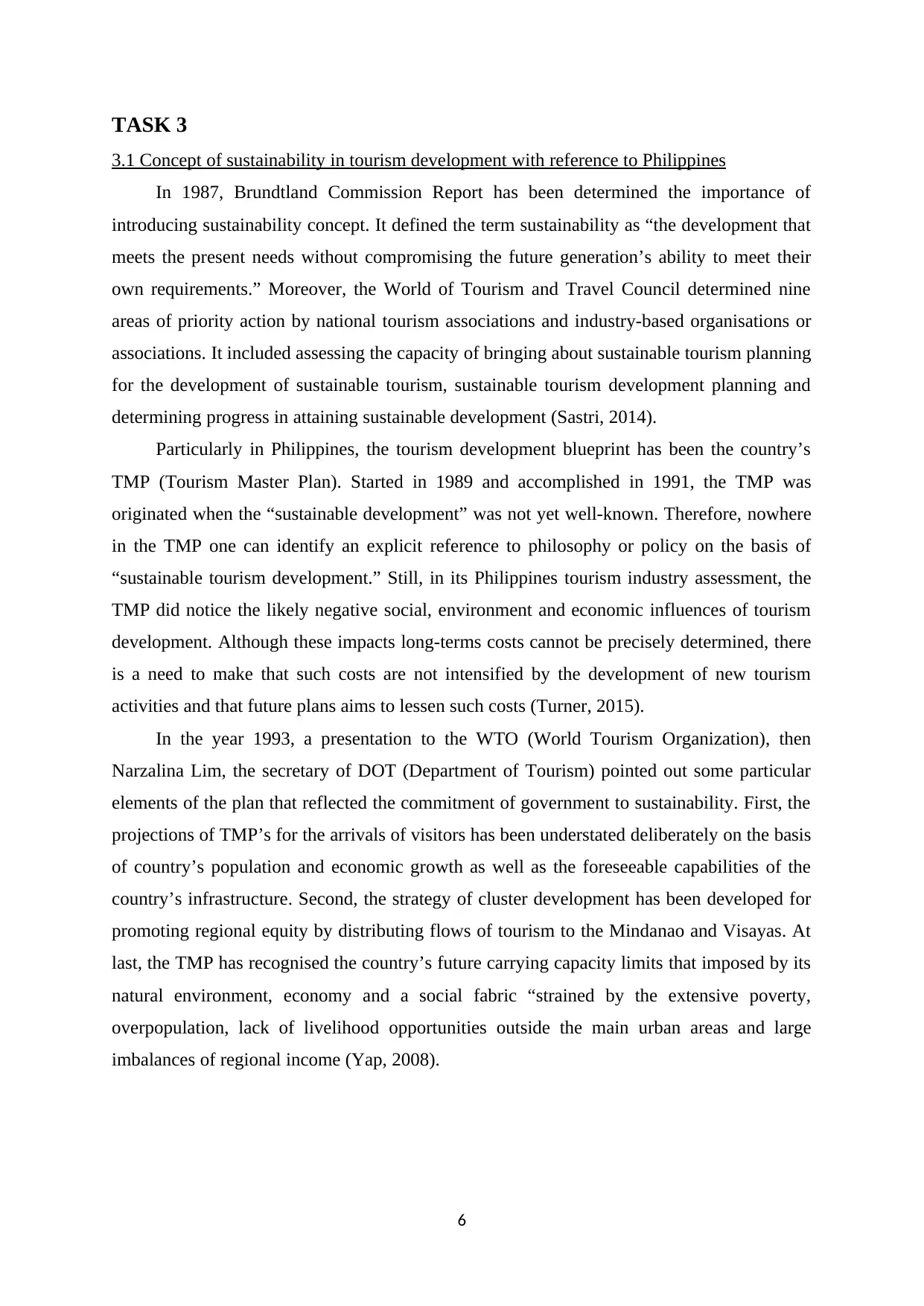
TASK 3
3.1 Concept of sustainability in tourism development with reference to Philippines
In 1987, Brundtland Commission Report has been determined the importance of
introducing sustainability concept. It defined the term sustainability as “the development that
meets the present needs without compromising the future generation’s ability to meet their
own requirements.” Moreover, the World of Tourism and Travel Council determined nine
areas of priority action by national tourism associations and industry-based organisations or
associations. It included assessing the capacity of bringing about sustainable tourism planning
for the development of sustainable tourism, sustainable tourism development planning and
determining progress in attaining sustainable development (Sastri, 2014).
Particularly in Philippines, the tourism development blueprint has been the country’s
TMP (Tourism Master Plan). Started in 1989 and accomplished in 1991, the TMP was
originated when the “sustainable development” was not yet well-known. Therefore, nowhere
in the TMP one can identify an explicit reference to philosophy or policy on the basis of
“sustainable tourism development.” Still, in its Philippines tourism industry assessment, the
TMP did notice the likely negative social, environment and economic influences of tourism
development. Although these impacts long-terms costs cannot be precisely determined, there
is a need to make that such costs are not intensified by the development of new tourism
activities and that future plans aims to lessen such costs (Turner, 2015).
In the year 1993, a presentation to the WTO (World Tourism Organization), then
Narzalina Lim, the secretary of DOT (Department of Tourism) pointed out some particular
elements of the plan that reflected the commitment of government to sustainability. First, the
projections of TMP’s for the arrivals of visitors has been understated deliberately on the basis
of country’s population and economic growth as well as the foreseeable capabilities of the
country’s infrastructure. Second, the strategy of cluster development has been developed for
promoting regional equity by distributing flows of tourism to the Mindanao and Visayas. At
last, the TMP has recognised the country’s future carrying capacity limits that imposed by its
natural environment, economy and a social fabric “strained by the extensive poverty,
overpopulation, lack of livelihood opportunities outside the main urban areas and large
imbalances of regional income (Yap, 2008).
6
3.1 Concept of sustainability in tourism development with reference to Philippines
In 1987, Brundtland Commission Report has been determined the importance of
introducing sustainability concept. It defined the term sustainability as “the development that
meets the present needs without compromising the future generation’s ability to meet their
own requirements.” Moreover, the World of Tourism and Travel Council determined nine
areas of priority action by national tourism associations and industry-based organisations or
associations. It included assessing the capacity of bringing about sustainable tourism planning
for the development of sustainable tourism, sustainable tourism development planning and
determining progress in attaining sustainable development (Sastri, 2014).
Particularly in Philippines, the tourism development blueprint has been the country’s
TMP (Tourism Master Plan). Started in 1989 and accomplished in 1991, the TMP was
originated when the “sustainable development” was not yet well-known. Therefore, nowhere
in the TMP one can identify an explicit reference to philosophy or policy on the basis of
“sustainable tourism development.” Still, in its Philippines tourism industry assessment, the
TMP did notice the likely negative social, environment and economic influences of tourism
development. Although these impacts long-terms costs cannot be precisely determined, there
is a need to make that such costs are not intensified by the development of new tourism
activities and that future plans aims to lessen such costs (Turner, 2015).
In the year 1993, a presentation to the WTO (World Tourism Organization), then
Narzalina Lim, the secretary of DOT (Department of Tourism) pointed out some particular
elements of the plan that reflected the commitment of government to sustainability. First, the
projections of TMP’s for the arrivals of visitors has been understated deliberately on the basis
of country’s population and economic growth as well as the foreseeable capabilities of the
country’s infrastructure. Second, the strategy of cluster development has been developed for
promoting regional equity by distributing flows of tourism to the Mindanao and Visayas. At
last, the TMP has recognised the country’s future carrying capacity limits that imposed by its
natural environment, economy and a social fabric “strained by the extensive poverty,
overpopulation, lack of livelihood opportunities outside the main urban areas and large
imbalances of regional income (Yap, 2008).
6
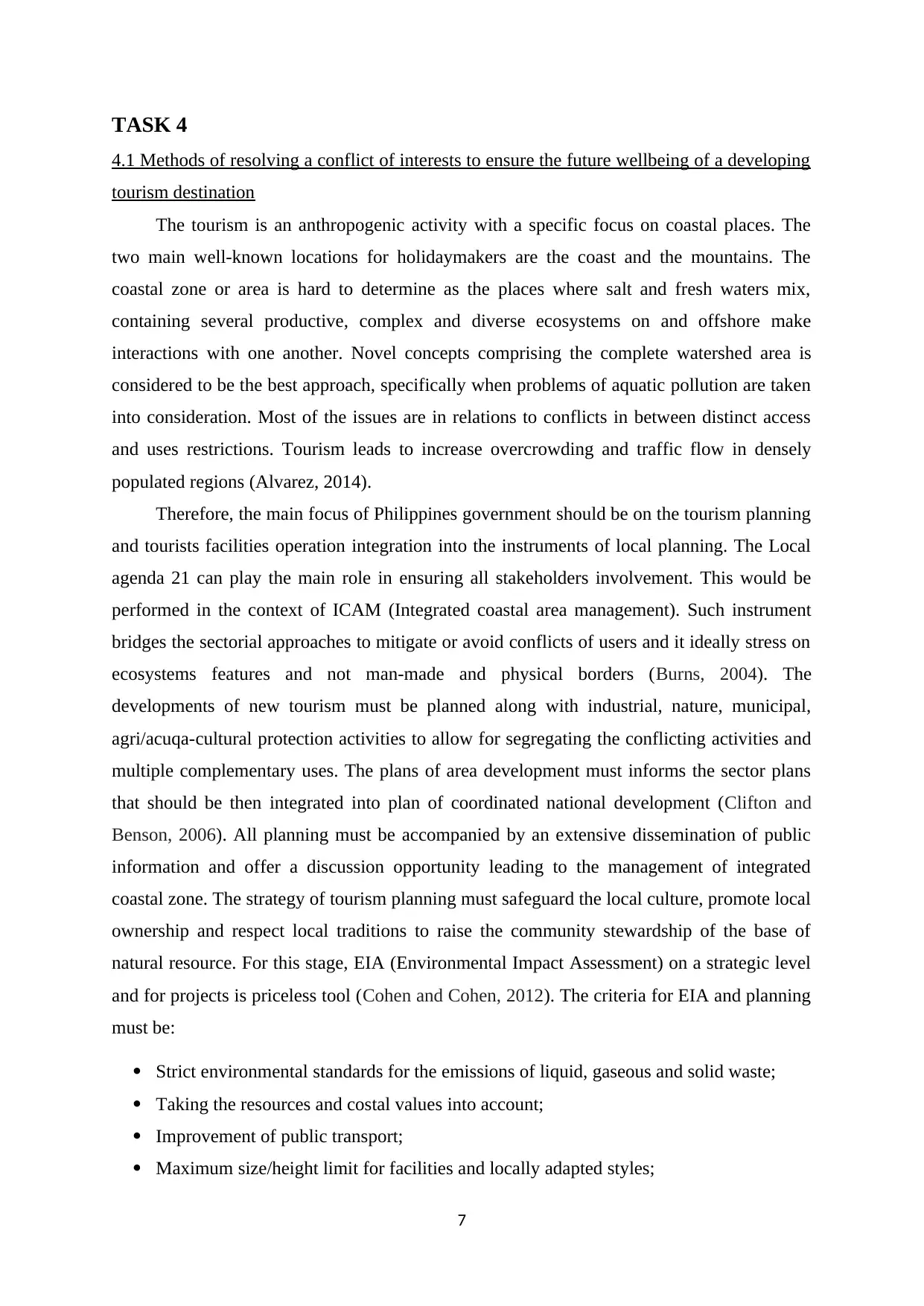
TASK 4
4.1 Methods of resolving a conflict of interests to ensure the future wellbeing of a developing
tourism destination
The tourism is an anthropogenic activity with a specific focus on coastal places. The
two main well-known locations for holidaymakers are the coast and the mountains. The
coastal zone or area is hard to determine as the places where salt and fresh waters mix,
containing several productive, complex and diverse ecosystems on and offshore make
interactions with one another. Novel concepts comprising the complete watershed area is
considered to be the best approach, specifically when problems of aquatic pollution are taken
into consideration. Most of the issues are in relations to conflicts in between distinct access
and uses restrictions. Tourism leads to increase overcrowding and traffic flow in densely
populated regions (Alvarez, 2014).
Therefore, the main focus of Philippines government should be on the tourism planning
and tourists facilities operation integration into the instruments of local planning. The Local
agenda 21 can play the main role in ensuring all stakeholders involvement. This would be
performed in the context of ICAM (Integrated coastal area management). Such instrument
bridges the sectorial approaches to mitigate or avoid conflicts of users and it ideally stress on
ecosystems features and not man-made and physical borders (Burns, 2004). The
developments of new tourism must be planned along with industrial, nature, municipal,
agri/acuqa-cultural protection activities to allow for segregating the conflicting activities and
multiple complementary uses. The plans of area development must informs the sector plans
that should be then integrated into plan of coordinated national development (Clifton and
Benson, 2006). All planning must be accompanied by an extensive dissemination of public
information and offer a discussion opportunity leading to the management of integrated
coastal zone. The strategy of tourism planning must safeguard the local culture, promote local
ownership and respect local traditions to raise the community stewardship of the base of
natural resource. For this stage, EIA (Environmental Impact Assessment) on a strategic level
and for projects is priceless tool (Cohen and Cohen, 2012). The criteria for EIA and planning
must be:
Strict environmental standards for the emissions of liquid, gaseous and solid waste;
Taking the resources and costal values into account;
Improvement of public transport;
Maximum size/height limit for facilities and locally adapted styles;
7
4.1 Methods of resolving a conflict of interests to ensure the future wellbeing of a developing
tourism destination
The tourism is an anthropogenic activity with a specific focus on coastal places. The
two main well-known locations for holidaymakers are the coast and the mountains. The
coastal zone or area is hard to determine as the places where salt and fresh waters mix,
containing several productive, complex and diverse ecosystems on and offshore make
interactions with one another. Novel concepts comprising the complete watershed area is
considered to be the best approach, specifically when problems of aquatic pollution are taken
into consideration. Most of the issues are in relations to conflicts in between distinct access
and uses restrictions. Tourism leads to increase overcrowding and traffic flow in densely
populated regions (Alvarez, 2014).
Therefore, the main focus of Philippines government should be on the tourism planning
and tourists facilities operation integration into the instruments of local planning. The Local
agenda 21 can play the main role in ensuring all stakeholders involvement. This would be
performed in the context of ICAM (Integrated coastal area management). Such instrument
bridges the sectorial approaches to mitigate or avoid conflicts of users and it ideally stress on
ecosystems features and not man-made and physical borders (Burns, 2004). The
developments of new tourism must be planned along with industrial, nature, municipal,
agri/acuqa-cultural protection activities to allow for segregating the conflicting activities and
multiple complementary uses. The plans of area development must informs the sector plans
that should be then integrated into plan of coordinated national development (Clifton and
Benson, 2006). All planning must be accompanied by an extensive dissemination of public
information and offer a discussion opportunity leading to the management of integrated
coastal zone. The strategy of tourism planning must safeguard the local culture, promote local
ownership and respect local traditions to raise the community stewardship of the base of
natural resource. For this stage, EIA (Environmental Impact Assessment) on a strategic level
and for projects is priceless tool (Cohen and Cohen, 2012). The criteria for EIA and planning
must be:
Strict environmental standards for the emissions of liquid, gaseous and solid waste;
Taking the resources and costal values into account;
Improvement of public transport;
Maximum size/height limit for facilities and locally adapted styles;
7
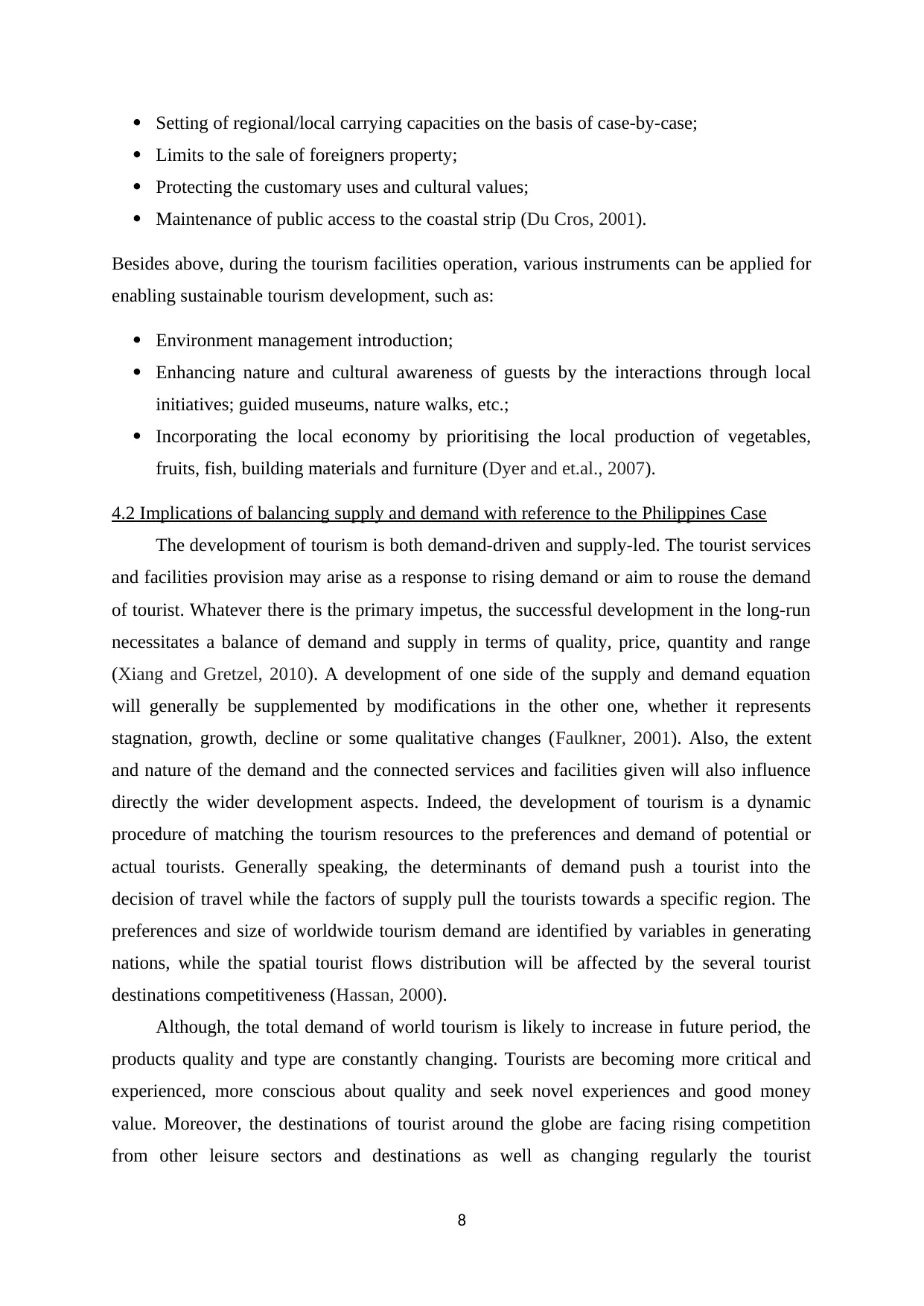
Setting of regional/local carrying capacities on the basis of case-by-case;
Limits to the sale of foreigners property;
Protecting the customary uses and cultural values;
Maintenance of public access to the coastal strip (Du Cros, 2001).
Besides above, during the tourism facilities operation, various instruments can be applied for
enabling sustainable tourism development, such as:
Environment management introduction;
Enhancing nature and cultural awareness of guests by the interactions through local
initiatives; guided museums, nature walks, etc.;
Incorporating the local economy by prioritising the local production of vegetables,
fruits, fish, building materials and furniture (Dyer and et.al., 2007).
4.2 Implications of balancing supply and demand with reference to the Philippines Case
The development of tourism is both demand-driven and supply-led. The tourist services
and facilities provision may arise as a response to rising demand or aim to rouse the demand
of tourist. Whatever there is the primary impetus, the successful development in the long-run
necessitates a balance of demand and supply in terms of quality, price, quantity and range
(Xiang and Gretzel, 2010). A development of one side of the supply and demand equation
will generally be supplemented by modifications in the other one, whether it represents
stagnation, growth, decline or some qualitative changes (Faulkner, 2001). Also, the extent
and nature of the demand and the connected services and facilities given will also influence
directly the wider development aspects. Indeed, the development of tourism is a dynamic
procedure of matching the tourism resources to the preferences and demand of potential or
actual tourists. Generally speaking, the determinants of demand push a tourist into the
decision of travel while the factors of supply pull the tourists towards a specific region. The
preferences and size of worldwide tourism demand are identified by variables in generating
nations, while the spatial tourist flows distribution will be affected by the several tourist
destinations competitiveness (Hassan, 2000).
Although, the total demand of world tourism is likely to increase in future period, the
products quality and type are constantly changing. Tourists are becoming more critical and
experienced, more conscious about quality and seek novel experiences and good money
value. Moreover, the destinations of tourist around the globe are facing rising competition
from other leisure sectors and destinations as well as changing regularly the tourist
8
Limits to the sale of foreigners property;
Protecting the customary uses and cultural values;
Maintenance of public access to the coastal strip (Du Cros, 2001).
Besides above, during the tourism facilities operation, various instruments can be applied for
enabling sustainable tourism development, such as:
Environment management introduction;
Enhancing nature and cultural awareness of guests by the interactions through local
initiatives; guided museums, nature walks, etc.;
Incorporating the local economy by prioritising the local production of vegetables,
fruits, fish, building materials and furniture (Dyer and et.al., 2007).
4.2 Implications of balancing supply and demand with reference to the Philippines Case
The development of tourism is both demand-driven and supply-led. The tourist services
and facilities provision may arise as a response to rising demand or aim to rouse the demand
of tourist. Whatever there is the primary impetus, the successful development in the long-run
necessitates a balance of demand and supply in terms of quality, price, quantity and range
(Xiang and Gretzel, 2010). A development of one side of the supply and demand equation
will generally be supplemented by modifications in the other one, whether it represents
stagnation, growth, decline or some qualitative changes (Faulkner, 2001). Also, the extent
and nature of the demand and the connected services and facilities given will also influence
directly the wider development aspects. Indeed, the development of tourism is a dynamic
procedure of matching the tourism resources to the preferences and demand of potential or
actual tourists. Generally speaking, the determinants of demand push a tourist into the
decision of travel while the factors of supply pull the tourists towards a specific region. The
preferences and size of worldwide tourism demand are identified by variables in generating
nations, while the spatial tourist flows distribution will be affected by the several tourist
destinations competitiveness (Hassan, 2000).
Although, the total demand of world tourism is likely to increase in future period, the
products quality and type are constantly changing. Tourists are becoming more critical and
experienced, more conscious about quality and seek novel experiences and good money
value. Moreover, the destinations of tourist around the globe are facing rising competition
from other leisure sectors and destinations as well as changing regularly the tourist
8
Secure Best Marks with AI Grader
Need help grading? Try our AI Grader for instant feedback on your assignments.
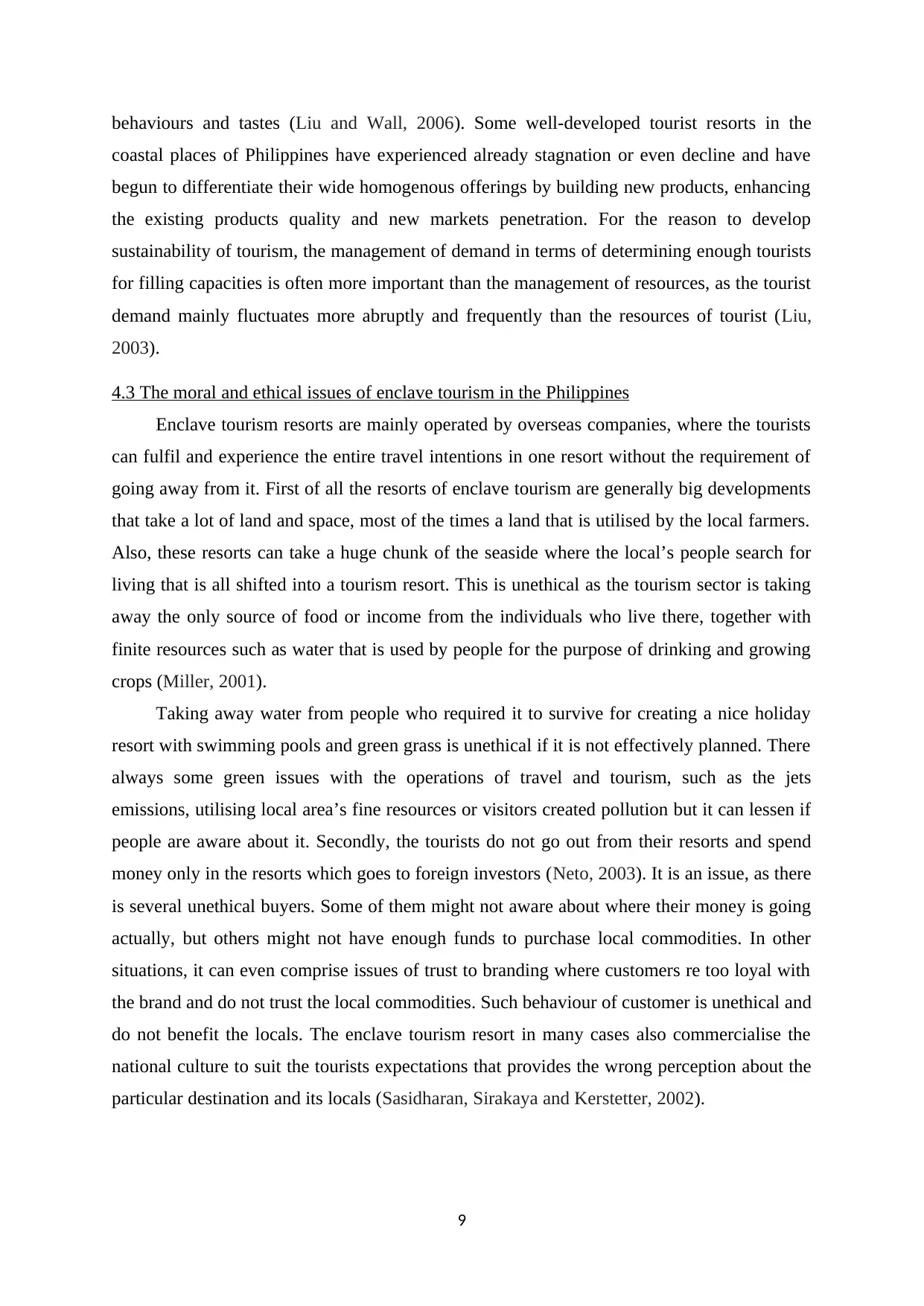
behaviours and tastes (Liu and Wall, 2006). Some well-developed tourist resorts in the
coastal places of Philippines have experienced already stagnation or even decline and have
begun to differentiate their wide homogenous offerings by building new products, enhancing
the existing products quality and new markets penetration. For the reason to develop
sustainability of tourism, the management of demand in terms of determining enough tourists
for filling capacities is often more important than the management of resources, as the tourist
demand mainly fluctuates more abruptly and frequently than the resources of tourist (Liu,
2003).
4.3 The moral and ethical issues of enclave tourism in the Philippines
Enclave tourism resorts are mainly operated by overseas companies, where the tourists
can fulfil and experience the entire travel intentions in one resort without the requirement of
going away from it. First of all the resorts of enclave tourism are generally big developments
that take a lot of land and space, most of the times a land that is utilised by the local farmers.
Also, these resorts can take a huge chunk of the seaside where the local’s people search for
living that is all shifted into a tourism resort. This is unethical as the tourism sector is taking
away the only source of food or income from the individuals who live there, together with
finite resources such as water that is used by people for the purpose of drinking and growing
crops (Miller, 2001).
Taking away water from people who required it to survive for creating a nice holiday
resort with swimming pools and green grass is unethical if it is not effectively planned. There
always some green issues with the operations of travel and tourism, such as the jets
emissions, utilising local area’s fine resources or visitors created pollution but it can lessen if
people are aware about it. Secondly, the tourists do not go out from their resorts and spend
money only in the resorts which goes to foreign investors (Neto, 2003). It is an issue, as there
is several unethical buyers. Some of them might not aware about where their money is going
actually, but others might not have enough funds to purchase local commodities. In other
situations, it can even comprise issues of trust to branding where customers re too loyal with
the brand and do not trust the local commodities. Such behaviour of customer is unethical and
do not benefit the locals. The enclave tourism resort in many cases also commercialise the
national culture to suit the tourists expectations that provides the wrong perception about the
particular destination and its locals (Sasidharan, Sirakaya and Kerstetter, 2002).
9
coastal places of Philippines have experienced already stagnation or even decline and have
begun to differentiate their wide homogenous offerings by building new products, enhancing
the existing products quality and new markets penetration. For the reason to develop
sustainability of tourism, the management of demand in terms of determining enough tourists
for filling capacities is often more important than the management of resources, as the tourist
demand mainly fluctuates more abruptly and frequently than the resources of tourist (Liu,
2003).
4.3 The moral and ethical issues of enclave tourism in the Philippines
Enclave tourism resorts are mainly operated by overseas companies, where the tourists
can fulfil and experience the entire travel intentions in one resort without the requirement of
going away from it. First of all the resorts of enclave tourism are generally big developments
that take a lot of land and space, most of the times a land that is utilised by the local farmers.
Also, these resorts can take a huge chunk of the seaside where the local’s people search for
living that is all shifted into a tourism resort. This is unethical as the tourism sector is taking
away the only source of food or income from the individuals who live there, together with
finite resources such as water that is used by people for the purpose of drinking and growing
crops (Miller, 2001).
Taking away water from people who required it to survive for creating a nice holiday
resort with swimming pools and green grass is unethical if it is not effectively planned. There
always some green issues with the operations of travel and tourism, such as the jets
emissions, utilising local area’s fine resources or visitors created pollution but it can lessen if
people are aware about it. Secondly, the tourists do not go out from their resorts and spend
money only in the resorts which goes to foreign investors (Neto, 2003). It is an issue, as there
is several unethical buyers. Some of them might not aware about where their money is going
actually, but others might not have enough funds to purchase local commodities. In other
situations, it can even comprise issues of trust to branding where customers re too loyal with
the brand and do not trust the local commodities. Such behaviour of customer is unethical and
do not benefit the locals. The enclave tourism resort in many cases also commercialise the
national culture to suit the tourists expectations that provides the wrong perception about the
particular destination and its locals (Sasidharan, Sirakaya and Kerstetter, 2002).
9
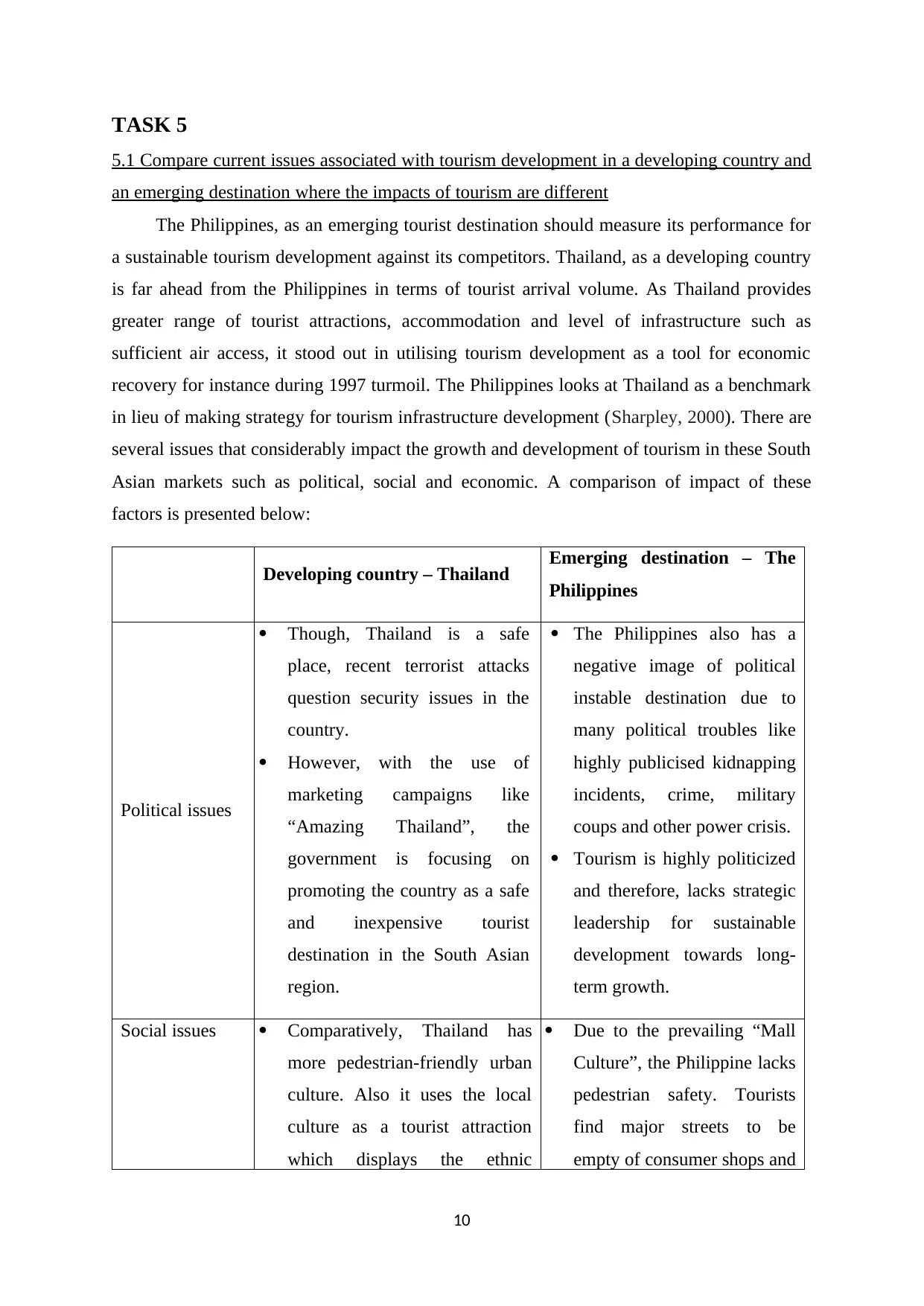
TASK 5
5.1 Compare current issues associated with tourism development in a developing country and
an emerging destination where the impacts of tourism are different
The Philippines, as an emerging tourist destination should measure its performance for
a sustainable tourism development against its competitors. Thailand, as a developing country
is far ahead from the Philippines in terms of tourist arrival volume. As Thailand provides
greater range of tourist attractions, accommodation and level of infrastructure such as
sufficient air access, it stood out in utilising tourism development as a tool for economic
recovery for instance during 1997 turmoil. The Philippines looks at Thailand as a benchmark
in lieu of making strategy for tourism infrastructure development (Sharpley, 2000). There are
several issues that considerably impact the growth and development of tourism in these South
Asian markets such as political, social and economic. A comparison of impact of these
factors is presented below:
Developing country – Thailand Emerging destination – The
Philippines
Political issues
Though, Thailand is a safe
place, recent terrorist attacks
question security issues in the
country.
However, with the use of
marketing campaigns like
“Amazing Thailand”, the
government is focusing on
promoting the country as a safe
and inexpensive tourist
destination in the South Asian
region.
The Philippines also has a
negative image of political
instable destination due to
many political troubles like
highly publicised kidnapping
incidents, crime, military
coups and other power crisis.
Tourism is highly politicized
and therefore, lacks strategic
leadership for sustainable
development towards long-
term growth.
Social issues Comparatively, Thailand has
more pedestrian-friendly urban
culture. Also it uses the local
culture as a tourist attraction
which displays the ethnic
Due to the prevailing “Mall
Culture”, the Philippine lacks
pedestrian safety. Tourists
find major streets to be
empty of consumer shops and
10
5.1 Compare current issues associated with tourism development in a developing country and
an emerging destination where the impacts of tourism are different
The Philippines, as an emerging tourist destination should measure its performance for
a sustainable tourism development against its competitors. Thailand, as a developing country
is far ahead from the Philippines in terms of tourist arrival volume. As Thailand provides
greater range of tourist attractions, accommodation and level of infrastructure such as
sufficient air access, it stood out in utilising tourism development as a tool for economic
recovery for instance during 1997 turmoil. The Philippines looks at Thailand as a benchmark
in lieu of making strategy for tourism infrastructure development (Sharpley, 2000). There are
several issues that considerably impact the growth and development of tourism in these South
Asian markets such as political, social and economic. A comparison of impact of these
factors is presented below:
Developing country – Thailand Emerging destination – The
Philippines
Political issues
Though, Thailand is a safe
place, recent terrorist attacks
question security issues in the
country.
However, with the use of
marketing campaigns like
“Amazing Thailand”, the
government is focusing on
promoting the country as a safe
and inexpensive tourist
destination in the South Asian
region.
The Philippines also has a
negative image of political
instable destination due to
many political troubles like
highly publicised kidnapping
incidents, crime, military
coups and other power crisis.
Tourism is highly politicized
and therefore, lacks strategic
leadership for sustainable
development towards long-
term growth.
Social issues Comparatively, Thailand has
more pedestrian-friendly urban
culture. Also it uses the local
culture as a tourist attraction
which displays the ethnic
Due to the prevailing “Mall
Culture”, the Philippine lacks
pedestrian safety. Tourists
find major streets to be
empty of consumer shops and
10
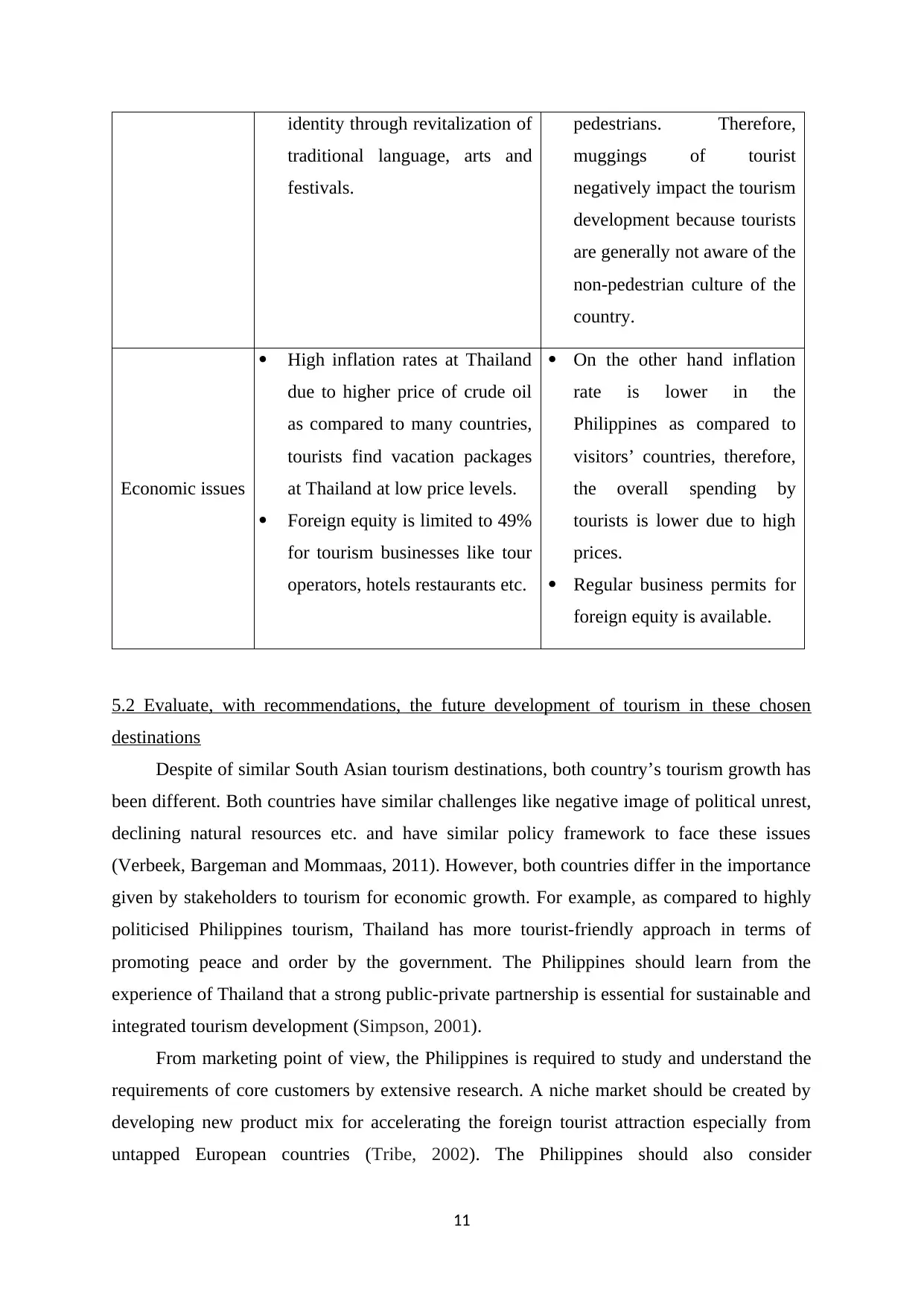
identity through revitalization of
traditional language, arts and
festivals.
pedestrians. Therefore,
muggings of tourist
negatively impact the tourism
development because tourists
are generally not aware of the
non-pedestrian culture of the
country.
Economic issues
High inflation rates at Thailand
due to higher price of crude oil
as compared to many countries,
tourists find vacation packages
at Thailand at low price levels.
Foreign equity is limited to 49%
for tourism businesses like tour
operators, hotels restaurants etc.
On the other hand inflation
rate is lower in the
Philippines as compared to
visitors’ countries, therefore,
the overall spending by
tourists is lower due to high
prices.
Regular business permits for
foreign equity is available.
5.2 Evaluate, with recommendations, the future development of tourism in these chosen
destinations
Despite of similar South Asian tourism destinations, both country’s tourism growth has
been different. Both countries have similar challenges like negative image of political unrest,
declining natural resources etc. and have similar policy framework to face these issues
(Verbeek, Bargeman and Mommaas, 2011). However, both countries differ in the importance
given by stakeholders to tourism for economic growth. For example, as compared to highly
politicised Philippines tourism, Thailand has more tourist-friendly approach in terms of
promoting peace and order by the government. The Philippines should learn from the
experience of Thailand that a strong public-private partnership is essential for sustainable and
integrated tourism development (Simpson, 2001).
From marketing point of view, the Philippines is required to study and understand the
requirements of core customers by extensive research. A niche market should be created by
developing new product mix for accelerating the foreign tourist attraction especially from
untapped European countries (Tribe, 2002). The Philippines should also consider
11
traditional language, arts and
festivals.
pedestrians. Therefore,
muggings of tourist
negatively impact the tourism
development because tourists
are generally not aware of the
non-pedestrian culture of the
country.
Economic issues
High inflation rates at Thailand
due to higher price of crude oil
as compared to many countries,
tourists find vacation packages
at Thailand at low price levels.
Foreign equity is limited to 49%
for tourism businesses like tour
operators, hotels restaurants etc.
On the other hand inflation
rate is lower in the
Philippines as compared to
visitors’ countries, therefore,
the overall spending by
tourists is lower due to high
prices.
Regular business permits for
foreign equity is available.
5.2 Evaluate, with recommendations, the future development of tourism in these chosen
destinations
Despite of similar South Asian tourism destinations, both country’s tourism growth has
been different. Both countries have similar challenges like negative image of political unrest,
declining natural resources etc. and have similar policy framework to face these issues
(Verbeek, Bargeman and Mommaas, 2011). However, both countries differ in the importance
given by stakeholders to tourism for economic growth. For example, as compared to highly
politicised Philippines tourism, Thailand has more tourist-friendly approach in terms of
promoting peace and order by the government. The Philippines should learn from the
experience of Thailand that a strong public-private partnership is essential for sustainable and
integrated tourism development (Simpson, 2001).
From marketing point of view, the Philippines is required to study and understand the
requirements of core customers by extensive research. A niche market should be created by
developing new product mix for accelerating the foreign tourist attraction especially from
untapped European countries (Tribe, 2002). The Philippines should also consider
11
Paraphrase This Document
Need a fresh take? Get an instant paraphrase of this document with our AI Paraphraser
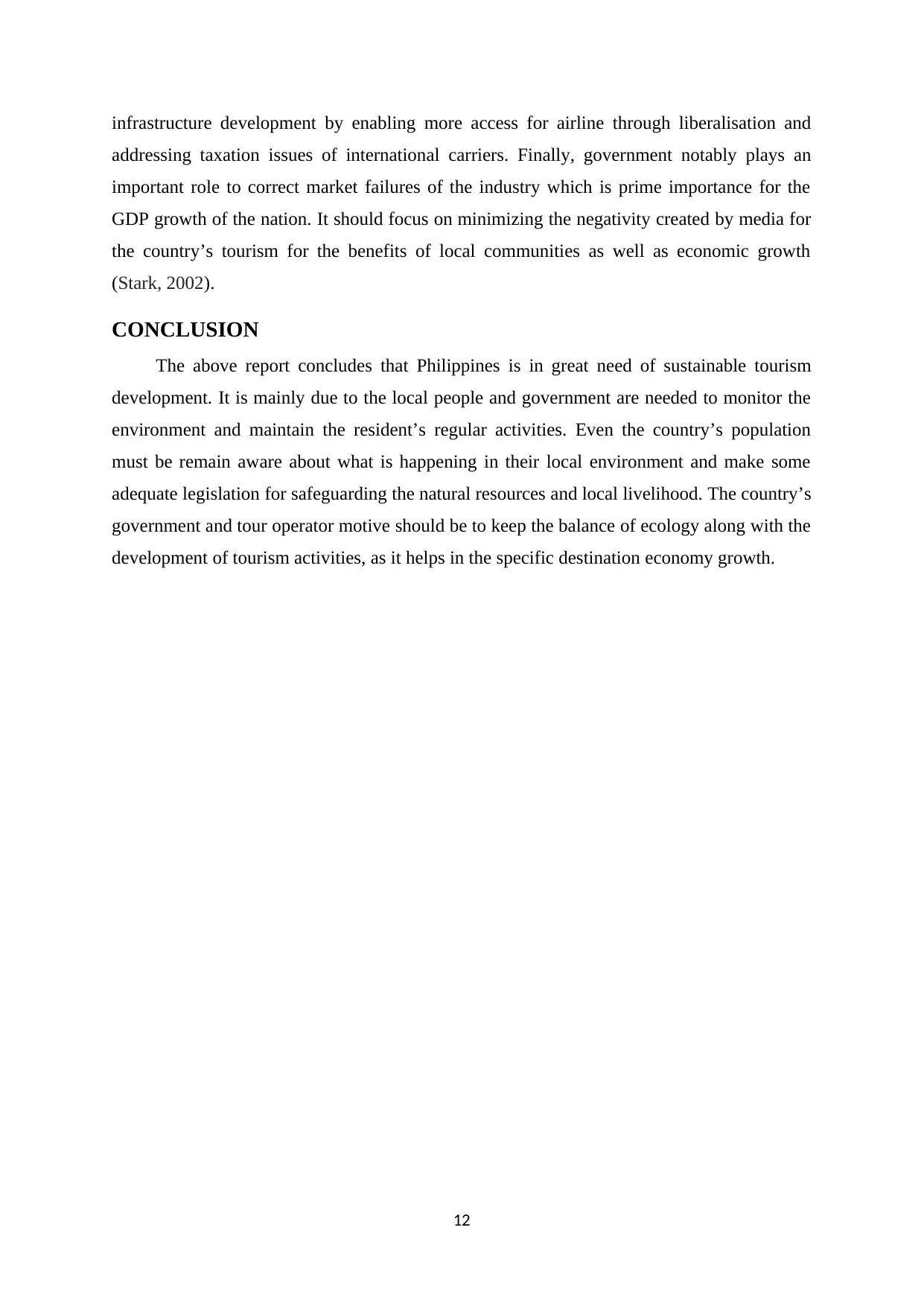
infrastructure development by enabling more access for airline through liberalisation and
addressing taxation issues of international carriers. Finally, government notably plays an
important role to correct market failures of the industry which is prime importance for the
GDP growth of the nation. It should focus on minimizing the negativity created by media for
the country’s tourism for the benefits of local communities as well as economic growth
(Stark, 2002).
CONCLUSION
The above report concludes that Philippines is in great need of sustainable tourism
development. It is mainly due to the local people and government are needed to monitor the
environment and maintain the resident’s regular activities. Even the country’s population
must be remain aware about what is happening in their local environment and make some
adequate legislation for safeguarding the natural resources and local livelihood. The country’s
government and tour operator motive should be to keep the balance of ecology along with the
development of tourism activities, as it helps in the specific destination economy growth.
12
addressing taxation issues of international carriers. Finally, government notably plays an
important role to correct market failures of the industry which is prime importance for the
GDP growth of the nation. It should focus on minimizing the negativity created by media for
the country’s tourism for the benefits of local communities as well as economic growth
(Stark, 2002).
CONCLUSION
The above report concludes that Philippines is in great need of sustainable tourism
development. It is mainly due to the local people and government are needed to monitor the
environment and maintain the resident’s regular activities. Even the country’s population
must be remain aware about what is happening in their local environment and make some
adequate legislation for safeguarding the natural resources and local livelihood. The country’s
government and tour operator motive should be to keep the balance of ecology along with the
development of tourism activities, as it helps in the specific destination economy growth.
12
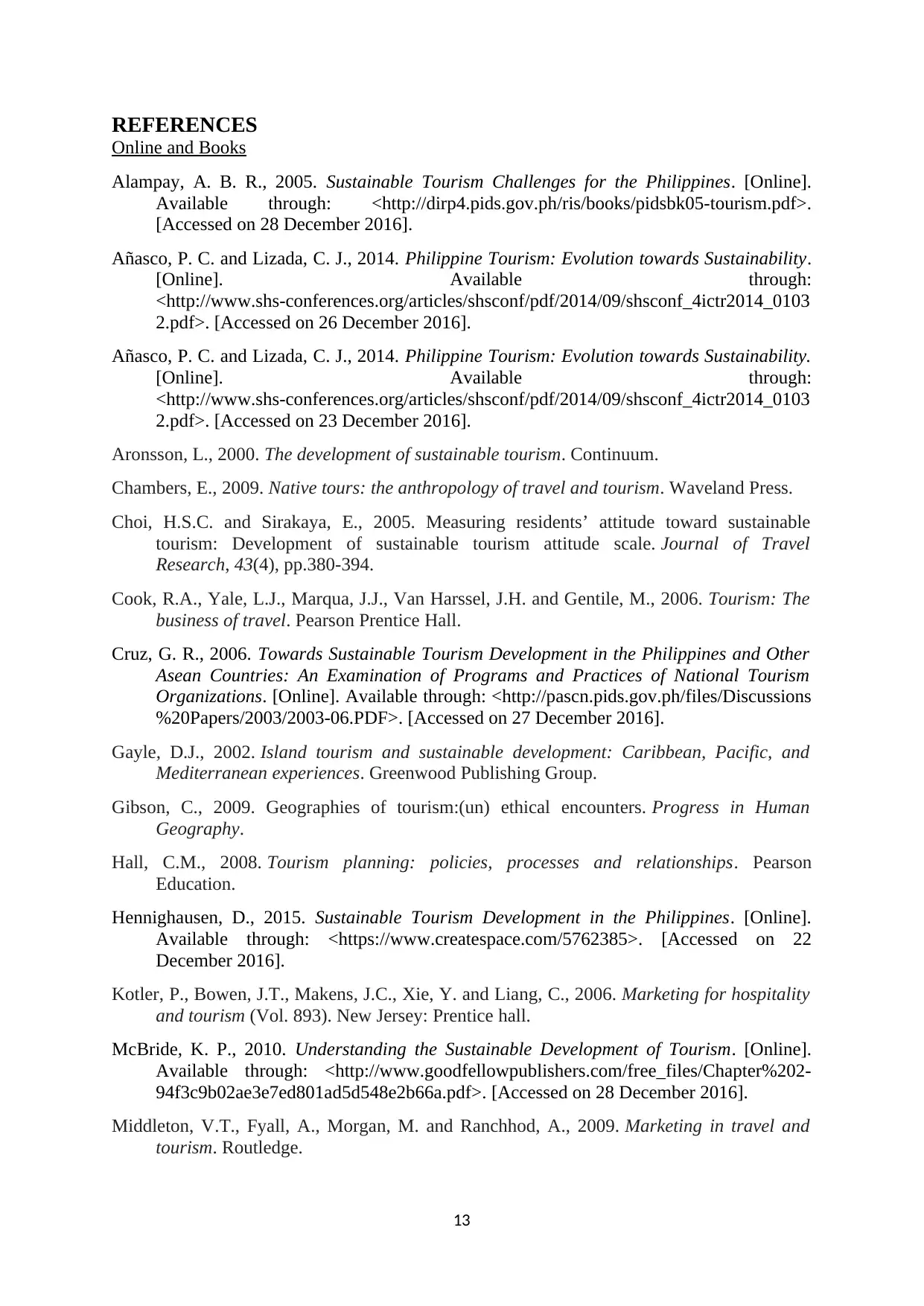
REFERENCES
Online and Books
Alampay, A. B. R., 2005. Sustainable Tourism Challenges for the Philippines. [Online].
Available through: <http://dirp4.pids.gov.ph/ris/books/pidsbk05-tourism.pdf>.
[Accessed on 28 December 2016].
Añasco, P. C. and Lizada, C. J., 2014. Philippine Tourism: Evolution towards Sustainability.
[Online]. Available through:
<http://www.shs-conferences.org/articles/shsconf/pdf/2014/09/shsconf_4ictr2014_0103
2.pdf>. [Accessed on 26 December 2016].
Añasco, P. C. and Lizada, C. J., 2014. Philippine Tourism: Evolution towards Sustainability.
[Online]. Available through:
<http://www.shs-conferences.org/articles/shsconf/pdf/2014/09/shsconf_4ictr2014_0103
2.pdf>. [Accessed on 23 December 2016].
Aronsson, L., 2000. The development of sustainable tourism. Continuum.
Chambers, E., 2009. Native tours: the anthropology of travel and tourism. Waveland Press.
Choi, H.S.C. and Sirakaya, E., 2005. Measuring residents’ attitude toward sustainable
tourism: Development of sustainable tourism attitude scale. Journal of Travel
Research, 43(4), pp.380-394.
Cook, R.A., Yale, L.J., Marqua, J.J., Van Harssel, J.H. and Gentile, M., 2006. Tourism: The
business of travel. Pearson Prentice Hall.
Cruz, G. R., 2006. Towards Sustainable Tourism Development in the Philippines and Other
Asean Countries: An Examination of Programs and Practices of National Tourism
Organizations. [Online]. Available through: <http://pascn.pids.gov.ph/files/Discussions
%20Papers/2003/2003-06.PDF>. [Accessed on 27 December 2016].
Gayle, D.J., 2002. Island tourism and sustainable development: Caribbean, Pacific, and
Mediterranean experiences. Greenwood Publishing Group.
Gibson, C., 2009. Geographies of tourism:(un) ethical encounters. Progress in Human
Geography.
Hall, C.M., 2008. Tourism planning: policies, processes and relationships. Pearson
Education.
Hennighausen, D., 2015. Sustainable Tourism Development in the Philippines. [Online].
Available through: <https://www.createspace.com/5762385>. [Accessed on 22
December 2016].
Kotler, P., Bowen, J.T., Makens, J.C., Xie, Y. and Liang, C., 2006. Marketing for hospitality
and tourism (Vol. 893). New Jersey: Prentice hall.
McBride, K. P., 2010. Understanding the Sustainable Development of Tourism. [Online].
Available through: <http://www.goodfellowpublishers.com/free_files/Chapter%202-
94f3c9b02ae3e7ed801ad5d548e2b66a.pdf>. [Accessed on 28 December 2016].
Middleton, V.T., Fyall, A., Morgan, M. and Ranchhod, A., 2009. Marketing in travel and
tourism. Routledge.
13
Online and Books
Alampay, A. B. R., 2005. Sustainable Tourism Challenges for the Philippines. [Online].
Available through: <http://dirp4.pids.gov.ph/ris/books/pidsbk05-tourism.pdf>.
[Accessed on 28 December 2016].
Añasco, P. C. and Lizada, C. J., 2014. Philippine Tourism: Evolution towards Sustainability.
[Online]. Available through:
<http://www.shs-conferences.org/articles/shsconf/pdf/2014/09/shsconf_4ictr2014_0103
2.pdf>. [Accessed on 26 December 2016].
Añasco, P. C. and Lizada, C. J., 2014. Philippine Tourism: Evolution towards Sustainability.
[Online]. Available through:
<http://www.shs-conferences.org/articles/shsconf/pdf/2014/09/shsconf_4ictr2014_0103
2.pdf>. [Accessed on 23 December 2016].
Aronsson, L., 2000. The development of sustainable tourism. Continuum.
Chambers, E., 2009. Native tours: the anthropology of travel and tourism. Waveland Press.
Choi, H.S.C. and Sirakaya, E., 2005. Measuring residents’ attitude toward sustainable
tourism: Development of sustainable tourism attitude scale. Journal of Travel
Research, 43(4), pp.380-394.
Cook, R.A., Yale, L.J., Marqua, J.J., Van Harssel, J.H. and Gentile, M., 2006. Tourism: The
business of travel. Pearson Prentice Hall.
Cruz, G. R., 2006. Towards Sustainable Tourism Development in the Philippines and Other
Asean Countries: An Examination of Programs and Practices of National Tourism
Organizations. [Online]. Available through: <http://pascn.pids.gov.ph/files/Discussions
%20Papers/2003/2003-06.PDF>. [Accessed on 27 December 2016].
Gayle, D.J., 2002. Island tourism and sustainable development: Caribbean, Pacific, and
Mediterranean experiences. Greenwood Publishing Group.
Gibson, C., 2009. Geographies of tourism:(un) ethical encounters. Progress in Human
Geography.
Hall, C.M., 2008. Tourism planning: policies, processes and relationships. Pearson
Education.
Hennighausen, D., 2015. Sustainable Tourism Development in the Philippines. [Online].
Available through: <https://www.createspace.com/5762385>. [Accessed on 22
December 2016].
Kotler, P., Bowen, J.T., Makens, J.C., Xie, Y. and Liang, C., 2006. Marketing for hospitality
and tourism (Vol. 893). New Jersey: Prentice hall.
McBride, K. P., 2010. Understanding the Sustainable Development of Tourism. [Online].
Available through: <http://www.goodfellowpublishers.com/free_files/Chapter%202-
94f3c9b02ae3e7ed801ad5d548e2b66a.pdf>. [Accessed on 28 December 2016].
Middleton, V.T., Fyall, A., Morgan, M. and Ranchhod, A., 2009. Marketing in travel and
tourism. Routledge.
13
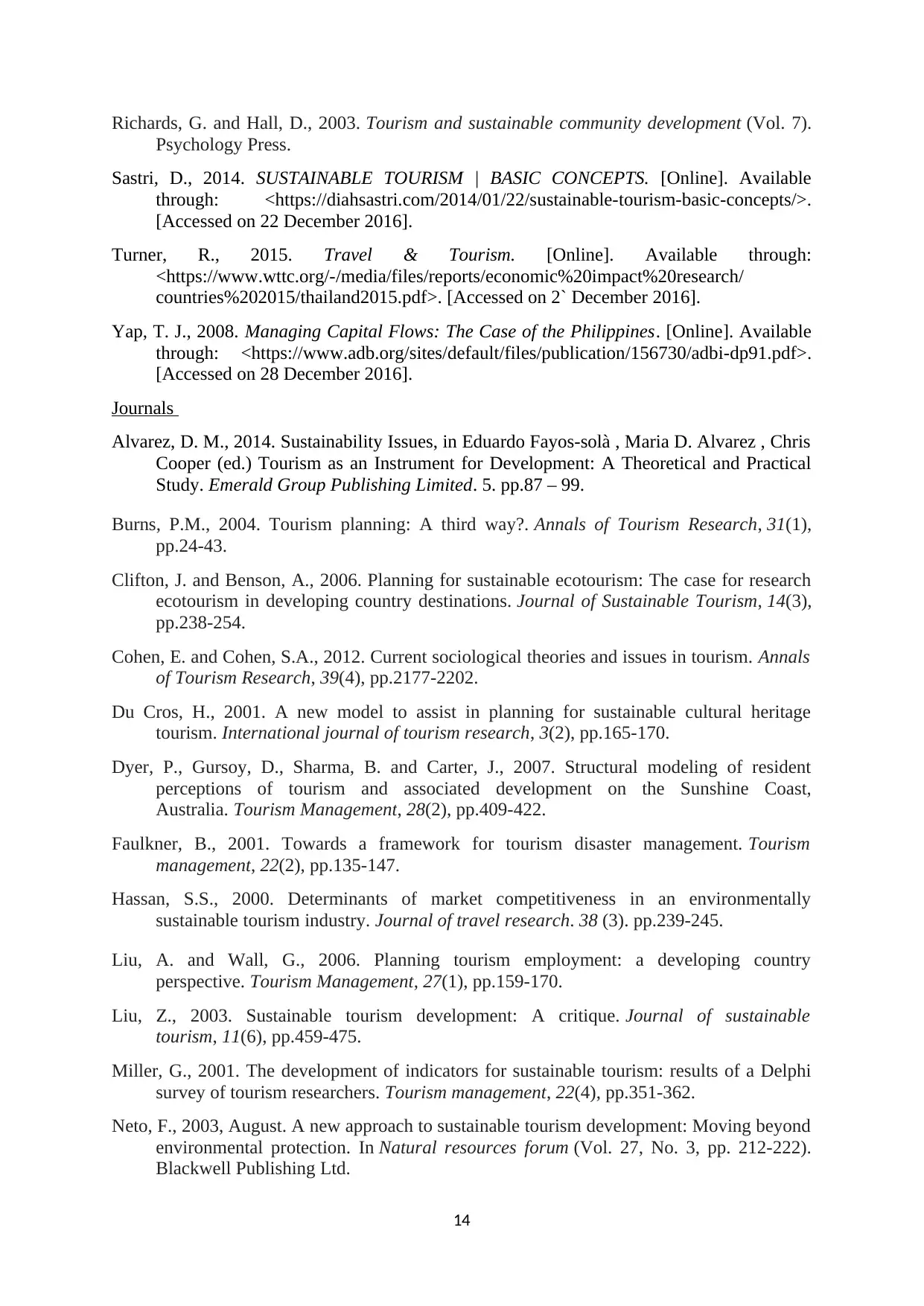
Richards, G. and Hall, D., 2003. Tourism and sustainable community development (Vol. 7).
Psychology Press.
Sastri, D., 2014. SUSTAINABLE TOURISM | BASIC CONCEPTS. [Online]. Available
through: <https://diahsastri.com/2014/01/22/sustainable-tourism-basic-concepts/>.
[Accessed on 22 December 2016].
Turner, R., 2015. Travel & Tourism. [Online]. Available through:
<https://www.wttc.org/-/media/files/reports/economic%20impact%20research/
countries%202015/thailand2015.pdf>. [Accessed on 2` December 2016].
Yap, T. J., 2008. Managing Capital Flows: The Case of the Philippines. [Online]. Available
through: <https://www.adb.org/sites/default/files/publication/156730/adbi-dp91.pdf>.
[Accessed on 28 December 2016].
Journals
Alvarez, D. M., 2014. Sustainability Issues, in Eduardo Fayos-solà , Maria D. Alvarez , Chris
Cooper (ed.) Tourism as an Instrument for Development: A Theoretical and Practical
Study. Emerald Group Publishing Limited. 5. pp.87 – 99.
Burns, P.M., 2004. Tourism planning: A third way?. Annals of Tourism Research, 31(1),
pp.24-43.
Clifton, J. and Benson, A., 2006. Planning for sustainable ecotourism: The case for research
ecotourism in developing country destinations. Journal of Sustainable Tourism, 14(3),
pp.238-254.
Cohen, E. and Cohen, S.A., 2012. Current sociological theories and issues in tourism. Annals
of Tourism Research, 39(4), pp.2177-2202.
Du Cros, H., 2001. A new model to assist in planning for sustainable cultural heritage
tourism. International journal of tourism research, 3(2), pp.165-170.
Dyer, P., Gursoy, D., Sharma, B. and Carter, J., 2007. Structural modeling of resident
perceptions of tourism and associated development on the Sunshine Coast,
Australia. Tourism Management, 28(2), pp.409-422.
Faulkner, B., 2001. Towards a framework for tourism disaster management. Tourism
management, 22(2), pp.135-147.
Hassan, S.S., 2000. Determinants of market competitiveness in an environmentally
sustainable tourism industry. Journal of travel research. 38 (3). pp.239-245.
Liu, A. and Wall, G., 2006. Planning tourism employment: a developing country
perspective. Tourism Management, 27(1), pp.159-170.
Liu, Z., 2003. Sustainable tourism development: A critique. Journal of sustainable
tourism, 11(6), pp.459-475.
Miller, G., 2001. The development of indicators for sustainable tourism: results of a Delphi
survey of tourism researchers. Tourism management, 22(4), pp.351-362.
Neto, F., 2003, August. A new approach to sustainable tourism development: Moving beyond
environmental protection. In Natural resources forum (Vol. 27, No. 3, pp. 212-222).
Blackwell Publishing Ltd.
14
Psychology Press.
Sastri, D., 2014. SUSTAINABLE TOURISM | BASIC CONCEPTS. [Online]. Available
through: <https://diahsastri.com/2014/01/22/sustainable-tourism-basic-concepts/>.
[Accessed on 22 December 2016].
Turner, R., 2015. Travel & Tourism. [Online]. Available through:
<https://www.wttc.org/-/media/files/reports/economic%20impact%20research/
countries%202015/thailand2015.pdf>. [Accessed on 2` December 2016].
Yap, T. J., 2008. Managing Capital Flows: The Case of the Philippines. [Online]. Available
through: <https://www.adb.org/sites/default/files/publication/156730/adbi-dp91.pdf>.
[Accessed on 28 December 2016].
Journals
Alvarez, D. M., 2014. Sustainability Issues, in Eduardo Fayos-solà , Maria D. Alvarez , Chris
Cooper (ed.) Tourism as an Instrument for Development: A Theoretical and Practical
Study. Emerald Group Publishing Limited. 5. pp.87 – 99.
Burns, P.M., 2004. Tourism planning: A third way?. Annals of Tourism Research, 31(1),
pp.24-43.
Clifton, J. and Benson, A., 2006. Planning for sustainable ecotourism: The case for research
ecotourism in developing country destinations. Journal of Sustainable Tourism, 14(3),
pp.238-254.
Cohen, E. and Cohen, S.A., 2012. Current sociological theories and issues in tourism. Annals
of Tourism Research, 39(4), pp.2177-2202.
Du Cros, H., 2001. A new model to assist in planning for sustainable cultural heritage
tourism. International journal of tourism research, 3(2), pp.165-170.
Dyer, P., Gursoy, D., Sharma, B. and Carter, J., 2007. Structural modeling of resident
perceptions of tourism and associated development on the Sunshine Coast,
Australia. Tourism Management, 28(2), pp.409-422.
Faulkner, B., 2001. Towards a framework for tourism disaster management. Tourism
management, 22(2), pp.135-147.
Hassan, S.S., 2000. Determinants of market competitiveness in an environmentally
sustainable tourism industry. Journal of travel research. 38 (3). pp.239-245.
Liu, A. and Wall, G., 2006. Planning tourism employment: a developing country
perspective. Tourism Management, 27(1), pp.159-170.
Liu, Z., 2003. Sustainable tourism development: A critique. Journal of sustainable
tourism, 11(6), pp.459-475.
Miller, G., 2001. The development of indicators for sustainable tourism: results of a Delphi
survey of tourism researchers. Tourism management, 22(4), pp.351-362.
Neto, F., 2003, August. A new approach to sustainable tourism development: Moving beyond
environmental protection. In Natural resources forum (Vol. 27, No. 3, pp. 212-222).
Blackwell Publishing Ltd.
14
Secure Best Marks with AI Grader
Need help grading? Try our AI Grader for instant feedback on your assignments.
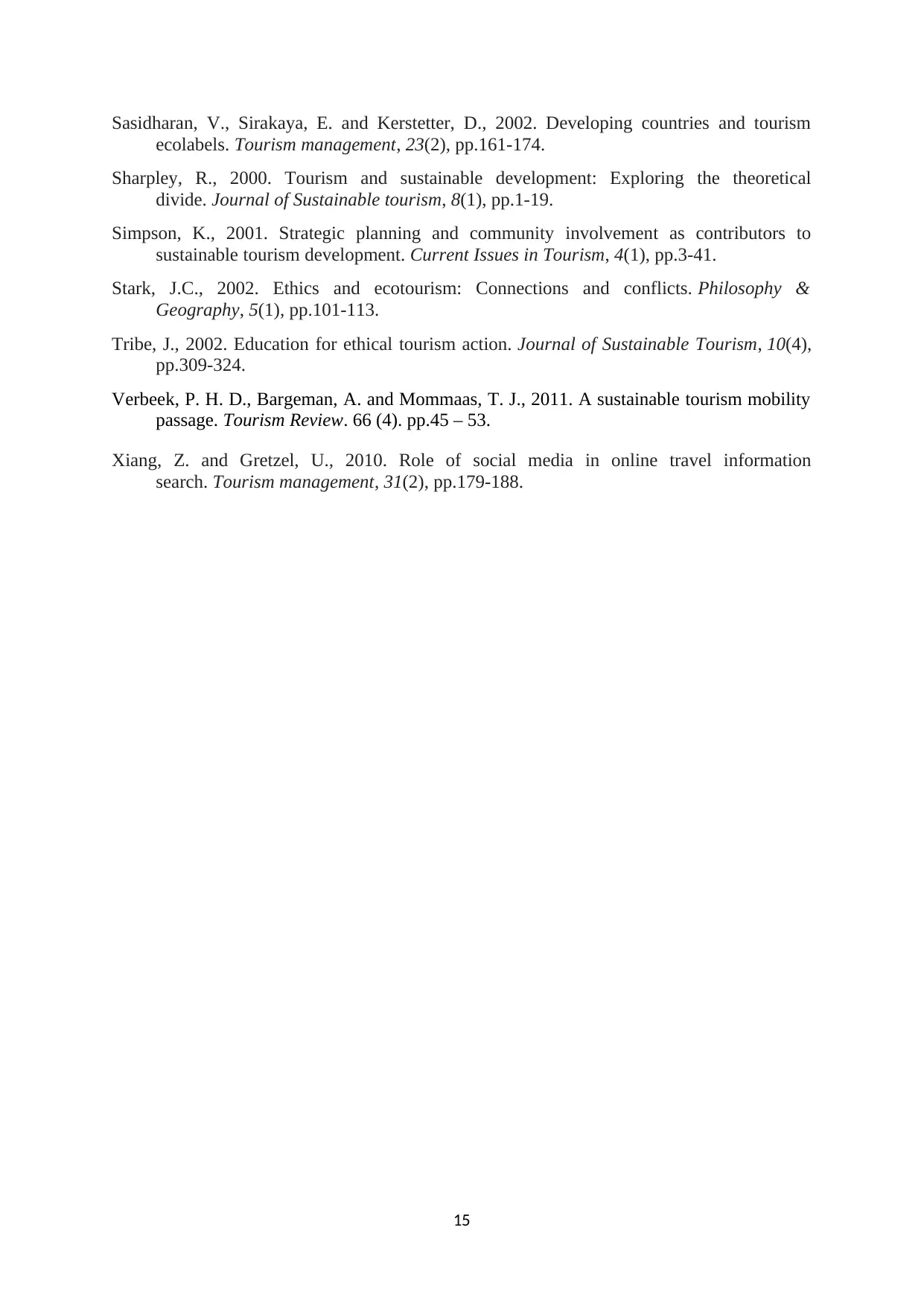
Sasidharan, V., Sirakaya, E. and Kerstetter, D., 2002. Developing countries and tourism
ecolabels. Tourism management, 23(2), pp.161-174.
Sharpley, R., 2000. Tourism and sustainable development: Exploring the theoretical
divide. Journal of Sustainable tourism, 8(1), pp.1-19.
Simpson, K., 2001. Strategic planning and community involvement as contributors to
sustainable tourism development. Current Issues in Tourism, 4(1), pp.3-41.
Stark, J.C., 2002. Ethics and ecotourism: Connections and conflicts. Philosophy &
Geography, 5(1), pp.101-113.
Tribe, J., 2002. Education for ethical tourism action. Journal of Sustainable Tourism, 10(4),
pp.309-324.
Verbeek, P. H. D., Bargeman, A. and Mommaas, T. J., 2011. A sustainable tourism mobility
passage. Tourism Review. 66 (4). pp.45 – 53.
Xiang, Z. and Gretzel, U., 2010. Role of social media in online travel information
search. Tourism management, 31(2), pp.179-188.
15
ecolabels. Tourism management, 23(2), pp.161-174.
Sharpley, R., 2000. Tourism and sustainable development: Exploring the theoretical
divide. Journal of Sustainable tourism, 8(1), pp.1-19.
Simpson, K., 2001. Strategic planning and community involvement as contributors to
sustainable tourism development. Current Issues in Tourism, 4(1), pp.3-41.
Stark, J.C., 2002. Ethics and ecotourism: Connections and conflicts. Philosophy &
Geography, 5(1), pp.101-113.
Tribe, J., 2002. Education for ethical tourism action. Journal of Sustainable Tourism, 10(4),
pp.309-324.
Verbeek, P. H. D., Bargeman, A. and Mommaas, T. J., 2011. A sustainable tourism mobility
passage. Tourism Review. 66 (4). pp.45 – 53.
Xiang, Z. and Gretzel, U., 2010. Role of social media in online travel information
search. Tourism management, 31(2), pp.179-188.
15
1 out of 17
Related Documents
Your All-in-One AI-Powered Toolkit for Academic Success.
+13062052269
info@desklib.com
Available 24*7 on WhatsApp / Email
![[object Object]](/_next/static/media/star-bottom.7253800d.svg)
Unlock your academic potential
© 2024 | Zucol Services PVT LTD | All rights reserved.





